EXPLORER THE
Stories, Superstitions and Beliefs

MEETING THE PEOPLE OF THE GALÁPAGOS ISLANDS
EXPLORING ANCIENT ROCK ART IN NAMIBIA THE STORY OF INDIA’S HOLIEST MEN



Stories, Superstitions and Beliefs

MEETING THE PEOPLE OF THE GALÁPAGOS ISLANDS
EXPLORING ANCIENT ROCK ART IN NAMIBIA THE STORY OF INDIA’S HOLIEST MEN


Writer and editor
North Carolina native Melissa has a passion for storytelling and travel. She’s lived all over the world, and is currently based in Lisbon. When she’s not writing you’ll find her searching for the best surf spots and plant-based food that Portugal has to offer. Melissa explores the human story of the Galápagos on page 16.
Next destination? Brazil
Writer
Born near the ocean, it was Beverley's destiny to love warm weather and stunning sunsets (yet she now lives in The Netherlands). Hailing from Mauritius, her main reasons for travelling are culture, food and adventure. She loves searching for inspiring travel stories; having travelled across most of Asia, she's now taking on Europe.
Next destination? Finland (brrrr)
Editor Jessie Brechin




Sub-editors
Melissa Haun
Beverley Lennon
Design
Extract Studio
Illustrations
Lauren Crow
Alicia Warner
With thanks to Metropolitan Touring
Wilderness
Top Indonesia
Original Senses, Greece
Southern Crossings, New Zealand
Maana Travel, Morocco
African Parks
Jacqueline
Cover Image
A Naga Sadhu holding rudraksha malatraditional prayer beads
Writer
Cape Town-based writer Terri spent over a decade in a busy print newsroom, before setting her sights on the enticing thrill of the travel industry. She loves exploring new places, and collecting unusual stories. When not off adventuring, you'll find her covered in flour in the kitchen, or up to her elbows in paint and glitter.


Next destination? Norway
Writer
Ten years ‘on the road’ finally came to an end when Emily swapped her backpack for a desk. Her travel career became a little less intrepid, but no less fun. She now lives in an English seaside town with her family, grappling with ambitious (impossible) home renovation projects and dreaming of faraway adventures.
Next destination? Morocco
The Explorer is published by Jacada Travel
Travel enquiries
enquiries@jacadatravel.com
US +1 646 895 8368
UK +44 20 3514 0977
Online jacadatravel.com
Writer
After extensive travel, most recently exploring and eating through as much of South-East Asia and Australia as possi ble, Emelie is now settled in Bristol. Whether she’s discovering new parts of England or jetting further round the globe, you’ll always find her with a coffee or beer in hand. A self-confessed bread addict and an official foodie.
Next destination? New Zealand
Visual Content
With a mixed heritage that spans continents, travel was always Alicia’s fate. With her camera by her side, she developed a passion and skill for visual storytelling and established her belief that travel creates the most joyous (and delicious) memories. An artist by nature, you can find her in London’s small studios, creating her own mini-masterpieces.
Next destination? Namibia
When you have finished with this magazine please recycle it.
Welcome to another issue of the Explorer magazine. Putting this together is a highlight of the year for our teams as we get to celebrate all of the things that we enjoy and are fascinated by in this world.
This is the thirteenth issue of Jacada’s magazine. Thirteen is an unlucky number for some as is often reflected in the lack of floor thirteen in hotels, or row thirteen on planes… but in some parts of the world thirteen means absolutely nothing at all, and other numbers take on the role of being a bad omen.
The way we see the world is inextricably linked with the stories, superstitions and beliefs that we grew up with and that were prevalent in our surroundings. What seems normal to someone from Scotland might seem bizarre to their South African colleague and vice versa.
Our team spans the globe and each inhabited continent, something that you can read a little more about on page 12. Together we bring a fascinating wealth of cultural knowledge and experiences that never ceases to amaze. Beyond the Jacada team itself, we know you’ll agree that travel opens our eyes to unique ways of life and different approaches to the world.
For this issue we’ve searched for the stories and beliefs that tie us together and set us apart. From the
often overlooked human history of the Galápagos Islands (on page 16) to Indian Sadhus, the nomadic tribes of Indonesia, and the ancient tribe responsible for some of the Earth’s oldest art, there are many stories to be explored. And no issue about story could be complete without a look at some old favourites: on page 48 you’ll find an exploration of Scandinavian mythology, and on page 56 we look at tales of sea monsters from around the world.
In the ‘Inspirations’ section we’ve pulled together some of the incredible experiences that our Jacada travellers have access to. These are ways to get under the skin of our destinations and get that little bit closer to the worlds we visit. Learn about the evil eye in Greece, explore the more ghoulish side of Edinburgh, meet traditional tradespeople in Ecuador or have dinner with a Maori family and learn about the meaning of nature.
Many thanks for your continued support of Jacada, it brings all of us a huge amount of joy to do what we do and to share the best of our world with you and yours. We hope you enjoy reading on and diving a little deeper into that world with us.
Wishing you all the best for 2023 and hoping to see you very soon,
Warm regards,
Alex Malcolm Founder
The latest news from the world of luxury travel
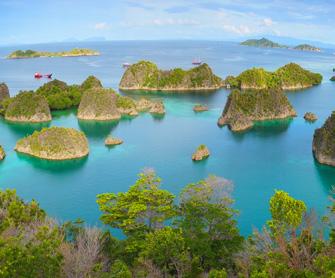

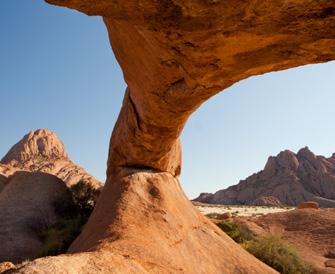
The intriguing history and human story of the Galápagos Islands
Emily Opie explores one of the world’s most ancient art forms in Namibia and the people who created it
Take a deep-dive into the underwater life of Indonesia’s Bajau people

The Naga Sadhus: India’s Holiest Men Beverley Lennon explores the sacred daily life and spiritual beliefs of India’s Naga Sadhus

Of Gods and Monsters
Fascinating insights into Scandinavia’s viking history and its Norse mythology


Here Be Dragons
A pocket guide to the many, mythical beasts that lurk in the waters around the world
Inspirations
64 Streets with Stories
Wandering the streets of Edinburgh: Scotland's spooky city
68
Struck by the Evil Eye
A Greek curse - and how to cure it
70
Faces of Quito
Jessie Brechin travels to Ecuador to meet the unique characters of Quito
74
Life of Pi(e)
A close-up on one of Morocco’s most delicious dishes
76
The Story of Nature
An exploration of meaningful Māori relationships with the natural world
80
A New Chapter Begins
Wilderness, our parent company embarks on a new journey
82
We chat with Jacada’s long-time clients and discover how they love to travel

With dramatic views out across the rocky peninsula of roquebrune-Cap-Martin, the Maybourne riviera which opened in mid-2022 is a fantastic new addition to the coastline. The modern hotel boasts rooms and spaces created by a team of celebrated architects and designers who were inspired by the Mediterranean Sea and its moods and movements. When it comes to dining, world-renowned chefs Mauro Colagreco and Jean-Georges Vongerichten are at the helm.
Openings and news in the luxury travel world.
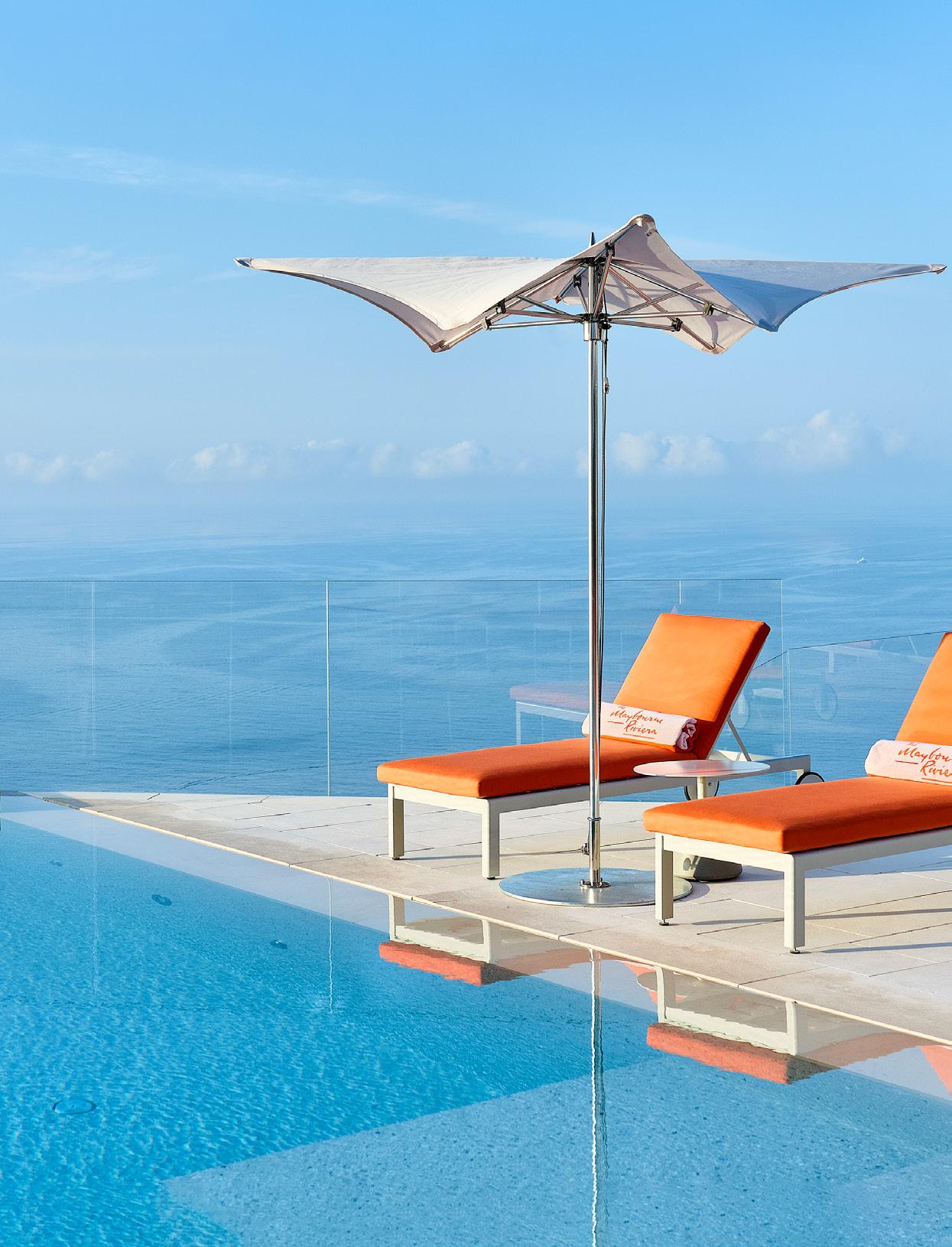
Marriott International will open its first safari lodge in 2023. Set in the Mara National reserve, JW Marriott Masai Mara Lodge will offer guests a distinctively elevated camp with 20 private tents overlooking the banks of the river Talek. As far as wildlife goes, the area is home to the Big Five, and between June and September the reserve also sees the annual great migration pass through.

It’s 150 years since Jules Verne’s thrilling adventure novel Around the World in Eighty Days landed on bookshelves and after many adaptations on film, TV and stage, as well as in print, the story still inspires travellers. The tale follows Phileas Fogg and his French valet Passepartout as they attempt to circumnavigate the world in 80 days in the hopes of winning a wager.
The Musée de Cluny has reopened its doors after two years of intensive renovation and modernisation. Situated in the heart of Paris, the museum plays host to one of the world’s most important collections of works of art dating back to the mediaeval period.
January 2023 marks the 250th anniversary of Captain James Cook and his crew sailing below the Antarctic Circle.
Last September, the Kingdom of Bhutan celebrated the reopening of its newly restored Trans Bhutan Trail. The sacred trail was originally part of the Silk road and dates back thousands of years. Today, the path connects 400 cultural and historic sites, showcasing the rich heritage of the country.

Tokyo maintains its reputation as the city with the most Michelin stars in the world. For 2023, it has recorded a total of 263 stars represented across 32 different types of cuisine.

Chile’s Atacama desert is one of the planet's most fascinating places. It might be the sunniest place on Earth and the world's driest non-polar desert, but occasionally, it transforms into a vivid carpet of colourful floral bloom, with over 200 species of flowers. This natural phenomenon has prompted the Chilean Government to name the region as its 44th national park.

In November 2021, rwanda’s Akagera National Park welcomed 30 white rhinos. The largest, single translocation of the species to date - breathing new life into the conservation of Africa’s threatened wildlife.
Ayoung white rhino calf accompanies its mother across Akagera National Park in rwanda, exploring their promising new environment. It’s a remarkable sight, and an encouraging glimmer of hope for the future of conservation.

Last year, the biggest rhino translocation to date took place. The mammoth 40-hour journey involved transporting 30 white rhinos by land and air in a Boeing 747 jet, from the Phinda reserve in South Africa to Akagera. Ambitious? definitely. But the potential to expand white rhino territory and create a new protected habitat for the species away from poachers outweighed the risks.
For centuries the rhinoceros has been a victim of man’s superstition. There are popular myths surrounding rhino horn that make it so sought after and, in turn, a high prize for poachers. In some parts of the world, they are used in traditional medicine to treat various ailments, although none of them have been proven to scientifically work. Others believe the horn itself is an aphrodisiac, and can produce sexual virility. For these reasons and more, the number of white rhinos in South Africa has suffered
over the past decade. due to poaching, the Kruger’s population alone has declined by 53% since 2013.
Ten years ago, no one would have put Akagera at the top of their list for wildlife rehabilitation. It was depleted and overrun by cattle, but the sheer size and potential of the national park caught the attention of multiple organisations. Over the past decade, organisations like NGO African Parks, the rwanda development Board and Wilderness have helped revive Akagera, turning it into a site fit for wildlife and sustainable tourism to thrive.
Since their relocation, the rhinos have been actively monitored and nurtured to make sure they settled into their new environment; they’re fitted with a tracker, and the park is continuously monitored by anti-poaching units and helicopter surveillance.
Although r wanda isn’t historically a location where white rhinos have existed, the results have been astounding. drew Bantlin, the park’s Conservation and research Manager, has described the population as “thriving” following the birth of multiple healthy calves. This is a great indicator that the rhinos are adapting well to their new surroundings, and creates a hopeful future for the population.
Outside of the rhinos themselves, locals in rwanda are benefitting from the translocation. 2022 is on track to see a record number of visitors in the area. With the travel and tourism sector flourishing, illegal jobs have been replaced with roles that benefit the environment and residents. Conservationists report that poaching has massively declined. Following the translocation, communities living adjacent to the park have developed a sense of pride and helped protect the area and its reintroduced species. The hospitality industry now plays a leading role in providing jobs and a stable income for the local community.
Excitingly, the introduction of rhinos, along with lions in 2015, has earnt Akagera the title of being a Big Five national park. On safari you can see thriving populations of lions, leopards, elephants, rhinos and buffalos, as well as zebras, giraffes and hundreds of bird species. The flourishing wildlife has quintupled the number of visitors to the park between 2005 and 2019.

Safaris in Akagera National Park are a great way to see - and support - rhinos during your stay in rwanda. The park itself offers incredible safari experiences, including walking and silent safaris, which are considered some of the most ethical ways to see rhinos and other wildlife. Wilderness Magashi Camp in particular, offers one of the best opportunities to see rhinos in rwanda. It sits in an exclusive 6,000 hectares of the Akagera National Park. The camp comprises six luxury tents on the shore of Lake rwanyakazinga, giving you a front row seat to the expansive wilderness.
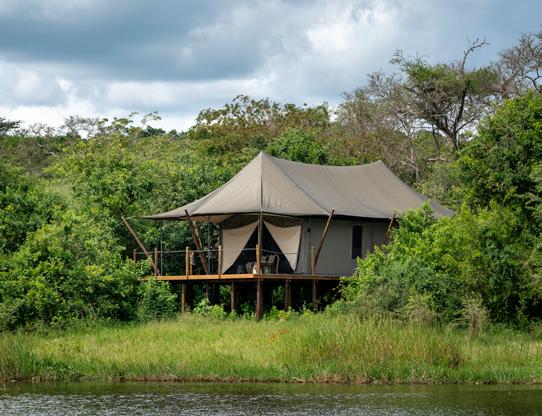
Meet some of the Jacada team and find out where they call home and the superstitions that come with the territory.
Our Jacada team is made up of a group of pretty incredible individuals - even if we say so ourselves. Between us there are plenty of hobbies, skills, pets, children and of course hundreds of travel stories to hear about. At the last count we were 49 people with 19 nationalities, based in 12 countries.
In our bustling London HQ there’s Londoners, adopted Londoners and folks who are just passing through or visiting from other cities or countries. Usually someone is about to set off on an adventure, while someone else is just returning with new travel stories and anecdotes joyfully being shared.
We’ve asked some of the team about the superstitions they know about, believe in, or as it turns out, subconsciously live by.
DAVID CORVACHO PUENTE Travel Designer for Latin America
Where are you from? Lima, Peru
Where’s home? I’ve been lucky enough to live all over the world and it’s been wonderful to call many different places home, if only for a short time. right now, for me and my family it’s London, but I think my heart will always call Peru home.
Tell us your superstition stories and where they’re from: Both of my superstitions stories are from Peru, I heard them growing up and they’re still passed down through the generations today.
In Peru we have a lot of mythology and superstitions surrounding mythical and magical elves and goblins - or ‘duende' in Spanish. Some duende are good and some are considered mischievous and even bad luck. One superstition is that you should leave open scissors next to the cot of a new born baby as it will protect them from the ‘bad’ elves that steal babies.
ALICIA WARNER Visual Content Executive
Where are you from? London, UK (with a mixed heritage from Thailand and Antigua)
Where’s home? I’ve been lucky enough to call London, Edinburgh, Thailand and the Maldives home at different points. Choosing one is very hard. I have probably spent marginally more time in London in the last couple of years so let's call London home for now.
Tell us your superstition stories and where they’re from: A fun one is from my motherland of Thailand - ชิ้นสุดท้ายแฟนหล่อ , which translates to ‘last piece handsome/ good looking boyfriend/girlfriend’, which means; if you eat the last piece of food you will have a good looking/handsome boyfriend/girlfriend. It’s a fun way to encourage young people to share food and to generally be kind and thoughtful.
Also from Thailand, another superstition story involves the protection of babies from scary ghosts. It’s believed by some that you should not compliment a baby as this makes them more attractive to ghosts and ghouls. This often results in newborns being given uncomplimentary nicknames such as “fat”, “pig” or “crab” to keep them safe; it’s no reflection at all on the families feelings towards the child of course.

Where are you from? I am from Nairobi, Kenya. We also identify with our ancestral homes, which for me is Kagilo, a village in Siaya County. Most families travel back to their father’s village to spend the holidays together - having your entire extended family together is a lot of fun.
Where’s home? I live in a neighbourhood called Kikuyu on the outskirts of Nairobi.
Tell us your superstition stories and where they’re from: My superstition is from my home country of Kenya, told by the Kikuyu tribe but also widely believed by others not from this tribe. The Kikuyu believe fig trees are sacred, often used as shrines, and that the spirits of their ancestors dwell within them. The superstition means that you may not hurt the tree in any way; if the tree falls, the branches, leaves, or any part that falls must be left alone to rot into the ground. Anyone who cuts down the tree, or uses the fallen parts will be followed around by bad luck.
CHARLIE MORRIS Travel Designer for AsiaWhere are you from? Tavistock in devon, UK
Where’s home? I’m from beautiful dartmoor, UK. The sort of place that stays in your heart as home forever. I’ve spent a long time living overseas working on super yachts. I now live on my little pink narrowboat which I moor on the canals of London.
Tell us your superstition stories and where they’re from: Never take bananas on a boat: Bananas became a bad omen because they would make all the fresh produce on a boat ripen and rot very quickly - not great if you’re at sea for a long time. due to my own bad-banana-luck experience, I’m on-board with this superstition. When I first started sailing I brought bananas onto the boat, as soon as we set sail the weather and tide turned against us. The engine cut out and left us powerless. It took hours to find a safe place to moor up, once in the dock we ceremoniously left the bananas on dry land and had plain sailing for the rest of the trip.
ELA HUGHES People and Culture Manager
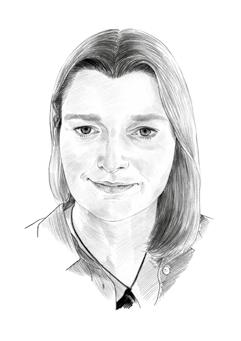
Where are you from? I’m from a tiny village in West Wales called Brongest.
Where’s home? I’ve lived in London for over 10 years but Wales is still very much home to me and I think it always will be, Welsh is also my first language.
Tell us your superstition stories and where they’re from: My story is, of course, from Wales. It’s not necessarily a superstition, more the story of a good luck charm and a ritual. I’m not entirely sure of the origin, but to celebrate romantic success (weddings, engagements, anniversaries) we give each other Lovespoons. Historically the spoons were carved from wood to display intricate, beautiful designs - each one would be unique. Now you can buy them in shops and there are metal and stone versions available but they are always very pretty and a sweet token of love and affection.
“It’s believed by some that you should not compliment a baby as this makes them more attractive to ghosts and ghouls.”

When you picture the Galápagos, what do you see?

Probably giant tortoises and blue-footed boobies, or perhaps pristine beaches and cloud-capped volcanoes. But humans have been here for centuries – and their stories are just as intriguing as the islands themselves.
Words: Melissa Haun
Images: Alicia Warner


Most people tend to think of the Galápagos Islands as an isolated paradise, devoid of human contact and cut off from the world. This is rooted in truth; the archipelago was discovered relatively recently, and has no native human inhabitants. However, in the centuries since, plenty of people have left their mark on this land, from sailors and scientists to pirates and prisoners.
If you ask us, the archipelago’s human history is just as fascinating as its flora and fauna – although these aspects are inextricably linked. We’ve delved into the islands’ past to find out who has lived, learned, died and disappeared here. We’ve also spoken with some of its modern-day residents, who are developing a unique culture rooted in coexistence with nature.
Let’s get to know the humans of the Galápagos.

Some say the first human to set foot in the Galápagos wasn’t European, but Inca. However, the most credible evidence we have suggests that the archipelago was officially discovered by Spaniard Fray Tomás de Berlanga, the Bishop of Panama. In 1535, he was on his way from Panama to Peru when his ship strayed off course and he ended up in the islands.
Berlanga apparently wasn’t very fond of the desolate, inhospitable land – and he certainly didn’t see it as paradise. In fact, he subsequently wrote a letter to the King of Spain advising him not to claim the islands, as there was nothing useful to be found there. He even likened them to purgatory, and compared the mournful giant tortoises to ‘grieving souls’.
Although the islands were still unclaimed, cartographers started adding them to maps of the Pacific. They were dubbed the ‘Galopegos’ after the tortoises; some are of the opinion that the word referred to the animals themselves, while others believe it referenced their resemblance to riding saddles. They were also sometimes called Las Encantadas (The Enchanted Isles), due to their tendency to appear and disappear amid the sea mist and unpredictable currents.
As word of the islands spread, other explorers started to visit (on purpose, unlike Berlanga). Most of them didn’t see much more value than he did, largely because of how hard it was to find food and fresh water in the unforgiving volcanic terrain. But that would soon change…
A place for pirates, sailors and whalers despite some early visitors’ lack of enthusiasm, others found the islands to be very useful indeed. They occupied a strategic position in the middle of the Pacific Ocean, which made them a perfect base for particular people.
First there were the pirates. Throughout the 1600s, the Galápagos provided an ideal hideout for buccaneers who made a business out of looting Spanish ships. They gave easy access to trade routes, allowing the pirates to make off with their booty and then retreat to a place where no one would ever think to look (or be able to find). They scraped by on the archipelago’s scarce resources, including the famous tortoises.
In fact, giant tortoises turned out to be an ideal food source for pirates and sailors. They would stack the animals in their ships’ holds and set sail. The tortoises could survive for several months at sea without food
“The archipelago’s human history is just as fascinating as its flora and fauna –although these aspects are inextricably linked.”
or water, so the crew could store them for as long as necessary before turning them into a meal. It sounds perverse now, but at the time these magnificent creatures were considered a valuable source of sustenance for malnourished sailors.

Then came the whalers. In the following century, British and American whaling ships began to arrive in the archipelago. They found abundant sperm whale and fur seal populations in the surrounding waters – a veritable windfall at a time when whale oil and seal skins were in high demand. It was around this time that the famous post office box was established on the island of Floreana, where whalers left letters for ships to carry back home to loved ones.
Throughout the early 1800s, economic interest in the Galápagos wreaked havoc on its natural environment and native species. Populations of whales, seals and giant tortoises all suffered devastating losses, driving them toward possible extinction. Further damage was caused by the introduction of invasive species and brush fires that devoured the dry landscape.
In 1835, a curious naturalist arrived in the Galápagos aboard the H.M.S. Beagle. His name was Charles d arwin, and in a few decades he would transform humanity’s understanding of the natural world. He spent around five weeks observing the environment and collecting specimens from four of the main islands.
It wasn’t until a couple of decades later that darwin put all the pieces together in his seminal book, On the Origin of Species. While in the Galápagos, he had observed how certain species seemed to have adapted to their surroundings over time. The islands’ extreme isolation and a relative lack of interference created ideal conditions to spark his theory of natural selection.
darwin may not have been the first or only scientist to visit the Galápagos Islands, but he was certainly the most influential. Since his findings were published in 1859, the archipelago has become strongly associated with the story of his voyage. This might explain why many people view the islands primarily as a wildlife haven, with less emphasis on their human history.
In the 1800s, humans finally started staking their claims in the Galápagos. The first known resident was an eccentric Irishman: Patrick Watkins, who took up residence on Floreana in 1805 (either by choice or because he was stranded). He apparently spent his time growing produce and trading it with passing ships, which kept him supplied with plenty of rum and other necessities. But just a few years later, he sailed away under mysterious circumstances; upon his arrival in Ecuador, all of his crew members had vanished.
No one else seemed to be interested in claiming the islands until 1832, when they were officially named a territory of Ecuador. Soon after, soldiers and economic opportunists started arriving from the mainland. Ecuador also created penal colonies on a few of the main islands, making political prisoners some of the Galápagos’ first residents.
Over the next century, people found plenty of valuable resources to exploit and export, from canned seafood and tortoise oil to sugarcane and coffee. Lots of early colonists came from Ecuador, but there were also waves of immigration from Norway and Germany. Many Europeans settled in Santa Cruz, Floreana and San Cristóbal, where they subsisted mostly on farming and fishing.
In the late 1920s, one of the Galapagos’ most legendary colonists arrived: Baroness Eloise von Wagner. Although her noble title was self-imposed, she was widely known as the Baroness, and even starred in a 1934 silent short film called The Empress of Floreana She became infamous for her sense of entitlement, her multiple lovers and her ill-conceived plan to build a luxury hotel on the island.
But the Baroness is best known for her untimely end. She mysteriously disappeared in 1934, along with one of her lovers, and was never heard from again. Another of her companions was later found mummified,
and her acquaintance dr. Friedrich ritter suddenly died of food poisoning. These mysterious events transformed the Baroness into legend; it’s said that her spirit still roams the islands looking for lonely men to visit in the middle of the night.
A few years later, the archipelago took on a strategic role in World War II. The United States military built an air base on Baltra Island in 1942, shortly after the attack on Pearl Harbor. Its effect on the islands was immeasurable, as infrastructure was quickly established to support thousands of new residents. The base closed a few years later, but its legacy lives on in the airport that was left behind – it’s where most travellers arrive in the islands to this day.
The shift toward conservation during the 20th century, the Galápagos started attracting the attention of the world’s scientific community. Many naturalists visited to collect samples and specimens for universities, museums and even the private




collections of wealthy sponsors. At the time this was a totally acceptable practice. It was viewed as a way of protecting native species from disappearing entirely, due to the increasing effects of human intervention on the islands.
But as it turns out, removing animals from their native habitats isn’t the best way to save them. In the 1930s a few international organisations decided to take action, and the first laws were passed to protect the Galápagos’ flora and fauna. In 1936, Ecuador officially designated the archipelago as a national reserve.
By the 1950s it was clear that further measures were needed. Conservationists from across the world spoke up on behalf of the islands, stressing the need for increased regulations and research. In 1959, Ecuador made all of the islands a national park – except for the areas that were already colonised, which comprised about 3% of the land.
The next year, the Charles darwin research Station was established to protect endangered animals, curb invasive species and educate the thousands of visitors who would continue seeking out the islands for decades to come. And the conservation work has continued; in 1998, a new law made the Galápagos the world’s second largest oceanic reserve. That same year, legislation was passed to keep the human population from growing too large.
Today there are around 30,000 residents of the Galápagos, most of whom live in Santa Cruz. The rest are spread throughout San Cristóbal, Isabela and Floreana,

while dozens of other islands remain uninhabited. The vast majority of Galapagueños work in tourism.
Life in the Galápagos might sound idyllic – and in some ways it is – but the islands’ residents also face some unique challenges. For example, the tap water isn’t potable and internet connections are notoriously slow. There are also strict rules about what can be imported, in order to avoid introducing harmful parasites or other threats to local ecosystems.
Fernando Zambrano, a naturalist guide and lifelong local, says that many visitors are shocked to find that people live in the Galápagos at all. He describes their amazement at seeing ‘iguanas, sea lions and grandpas reading their newspapers’ side by side. But as he points out, people were here long before the national park was established – and the islands’ residents are still figuring out how to live in harmony with everything that designation entails.
According to Fernando, their ultimate goal is to make the Galápagos a better place for everybody; a place where science, communities and tourism can coexist in harmony. That certainly sounds like paradise to us.
Start planning your adventure to the Galápagos Islands. → enquiries@jacadatravel.com
“Life in the Galápagos might sound idyllic – and in some ways it is – but the islands’ residents also face some unique challenges.”
Many millennia ago, the story of the San began to unfold on Namibia’s dramatic landscapes. Enormous amounts of ancient rock art, along with today's living culture, reveals a fascinating narrative on the San way of life.
Words: Emily Opie
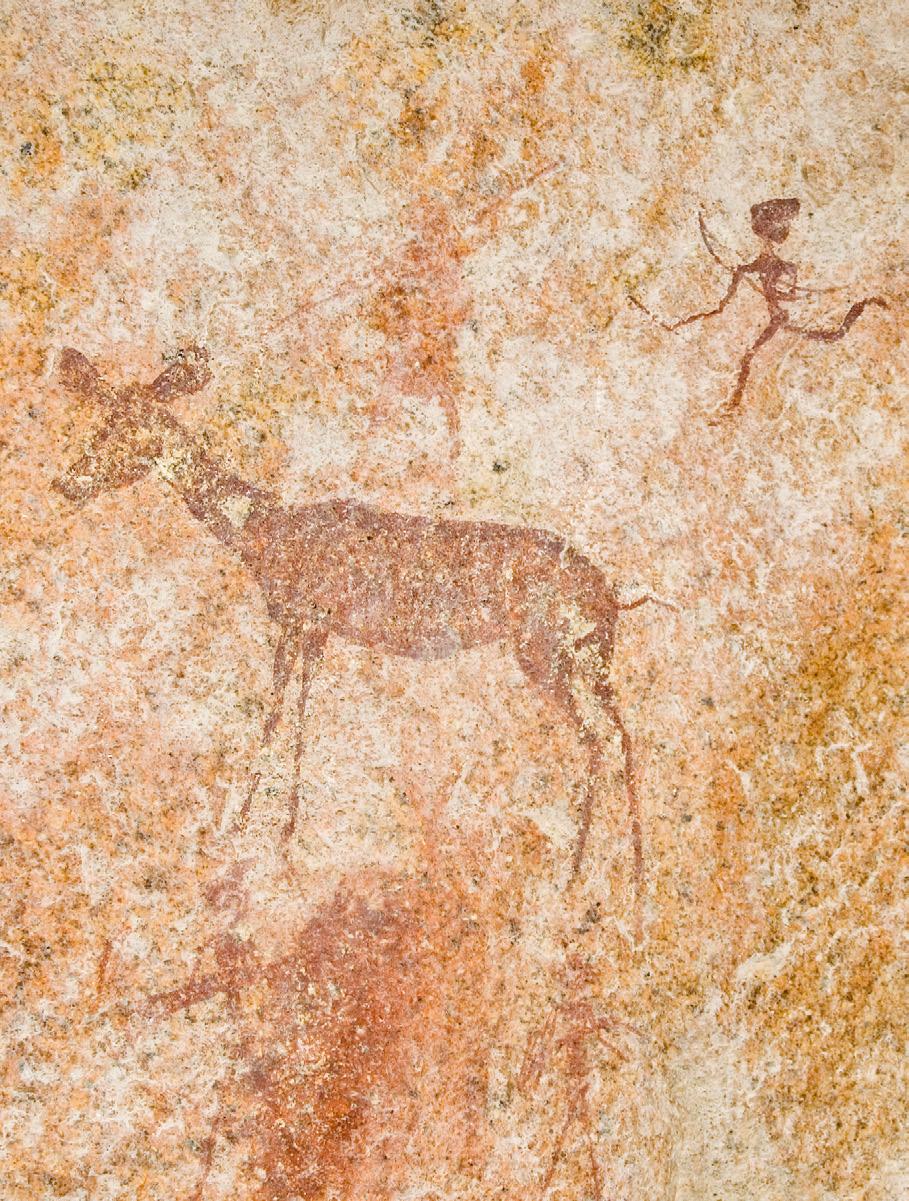
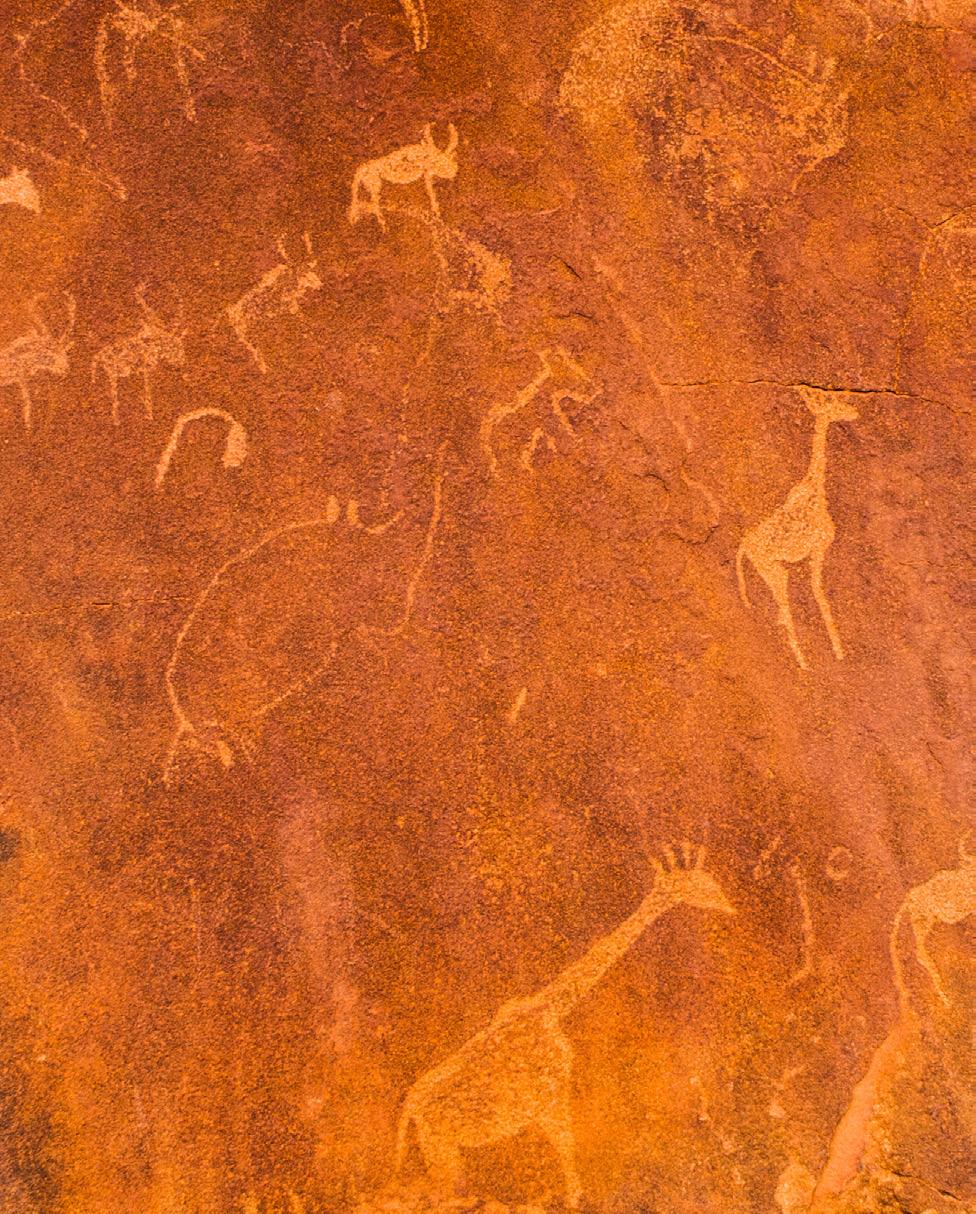
The story of the San people is ancient. Their culture dates back over 20,000 years - a timescale that’s hard to comprehend, and so far away it’s difficult to connect with. Yet today, in southern Africa, their story is entirely human with over 100,000 San still living there, some according to their ancestral lifestyle. It’s a story of family, community, culture, of children playing in the desert, of strong women and respectful gender relationships. It’s a story many of us can recognise.

However, there is a parallel story, another thread, that’s engraved on rock faces, overhanging ledges, caves and plateaus. A story of intrigue, allusion and speculation. It’s a story of rituals, medicine men and mythical African centaurs shown in San rock art, found all over Namibia’s lunar-like landscapes.
The San are a hunter-gatherer, semi-nomadic culture whose ancestors have lived on the land that’s now Namibia since the Stone Age. A desert country of vast arid landscapes, punctuated by rocky outcrops and huge orange sand dunes, under a bed of deep blue skies or endless, far-reaching stars.

The San’s affinity with this land is staggering; they possess an extensive, indige-
nous knowledge used to survive in what can be perceived as an incredibly inhospitable environment. However, with just a morsel of San knowledge, it’s possible to see how Namibia is in fact, full of life. The Kalahari d esert becomes lush after a sprinkling of rain, and underground rivers steadily trickle. There are dense areas of prickly bushes that grow berries and small fruits, blankets of edible flowers and the mighty, moisture-rich baobab tree.
To make the most of Namibia’s life-giving properties, the San moved in harmony with the seasons, gathering the resources the land provided for them. They notice the small and minute, eating many species of bugs and insects to gain crucial nutrients. They’re expert trackers, with incredible hunting prowess. They can get so close to large prey, such as zebras and giraffes, and are so efficient at shooting that simply one shot of their poison arrows can bring down their target. Understanding their environment and working with it, not against it, means the land has become a vital support system for them, in a world that at times, seems determined to disrupt them. Their enduring survival is no doubt testament to an incredible resourcefulness, patience and skill as hunters and gatherers.
Some aspects of ancient San culture resonate today, reflecting some of our own ways of life
- either at home or within wider society. Historically, family groups were egalitarian and important decisions were made together. Anthropologists report that women played a significant role in San society, unlike children who had no role at all, except to be children, playing and learning with each other and their elders. There’s also an understanding that for the ancient San, relaxation and enjoyment played an important part in day to day life - ‘selfcare’ is nothing new.
A fascinating and important part of San culture are rituals and ceremonies, often involving dance, the most significant being
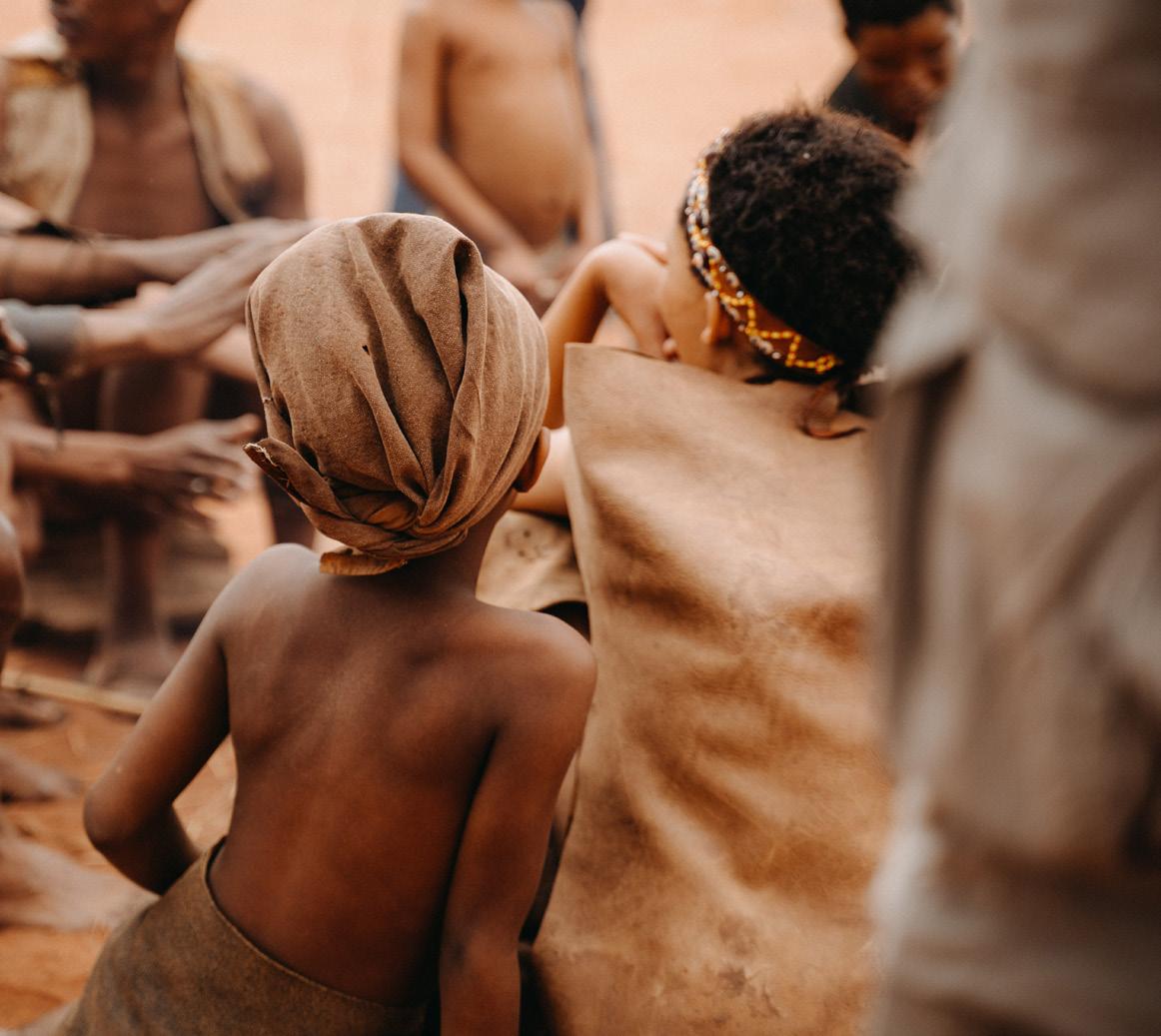
the trance dance. Taking place at night, next to a small but intense fire, the women sit on the floor and clap out a rhythm which the men dance to. rhythmic breathing and intense concentration cause a type of hyperventilation, sending the men into trance.
It is believed that the spirits of dead animals, curious of the fire, clapping and noise of the rhythmic breathing, will gingerly approach the ceremony. As the animal spirits stand back, just outside the circle of firelight that licks at the darkness, the men will notice them. Additional movements are then added to the dance as they point
“Taking place at night, next to a small but intense fire, the women sit on the floor and clap out a rhythm which the men dance to.”
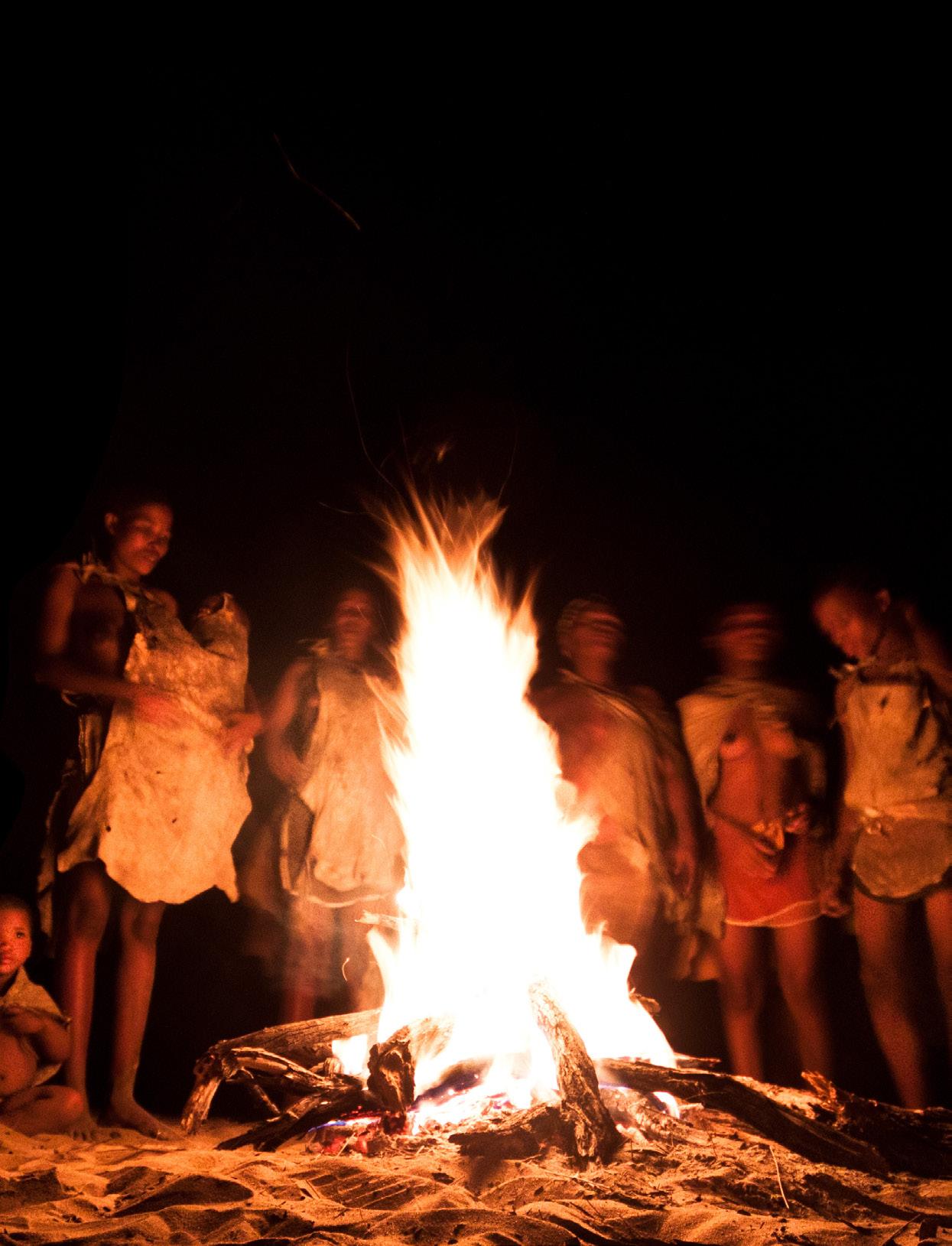 Left. Many San rituals and ceremonies take place around an intense fire.
Right. The San’s handmade trinkets hang from a tree in the Kalahari desert.
Left. Many San rituals and ceremonies take place around an intense fire.
Right. The San’s handmade trinkets hang from a tree in the Kalahari desert.

to the spirit animal and alert one another to its presence. Often the ‘medicine man’ or healer of the group, will communicate with the spirits, asking them for help such as sending rain or healing the sick.
depictions of the trance dance, among other scenes, can be found all over Namibia in the form of ancient rock art and engravings. Some images are thought to be over 20,000 years old, so there’s inevitable speculation (often due to corrosion over time) of what exactly these images represent.
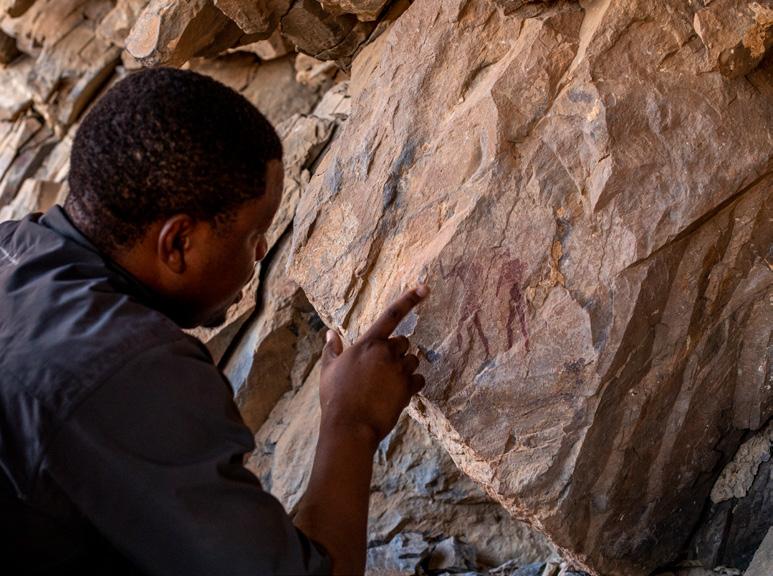
It’s not entirely clear who made the art. It’s widely accepted that women did notthere are no images of ‘gathering’, mainly just of rituals and hunting which were traditionally the role of the men. Some believe that it’s the ‘medicine men’ who drew self portrait-like scenes of the trance dance. This could explain the inclusion of half-human, half-animal hybrids which represent their communication with spirit animals.
Further speculation has arisen from a theory that white paint deteriorates quicker than other colours, possibly leading to a complete misinterpretation of some pictures. A lion attacking eland, it turns out, is perhaps a herd of ‘headless’ eland whose white heads have worn away, creating the illusion of a lion kill.
One of Namibia’s most curious images is the ‘White Lady’, nestled deep within the Brandberg Mountains. A typical hunting scene of human figures and oryx but with an additional, intriguing figure. Larger than the others, with long white arms and legs, holding a goblet and bow. There doesn’t appear to be anyone else quite like ‘her’ found in other San rock art.
There's a fascinating hypothesis that the ‘White Lady’ image was not created by the San at all, but rather a civilisation outside of Africa. due to correlations with art found in the Levant, it may have been created by a hand from an ancient civilization known as Phoenicia. A true twist in the tale of the San. Another topic theorised in detail, with no definitive answer is; why is the art here at all? Perhaps the San were simply telling their story. Artworks from the 19th century support this idea of art acting as a social commentary of the time. The San, clearly exposed to different cultures, painted a dutch sailing boat, wagons, guns and people in European dress on rocks close to the South African town of Porterville.
A large proportion of San rock art, utterly captivating in its own right, when framed by Namibia’s monumentally, breathtaking landscapes, becomes even more fascinating. One such, otherworldly San rock art site is Spitzkoppe, so visually striking
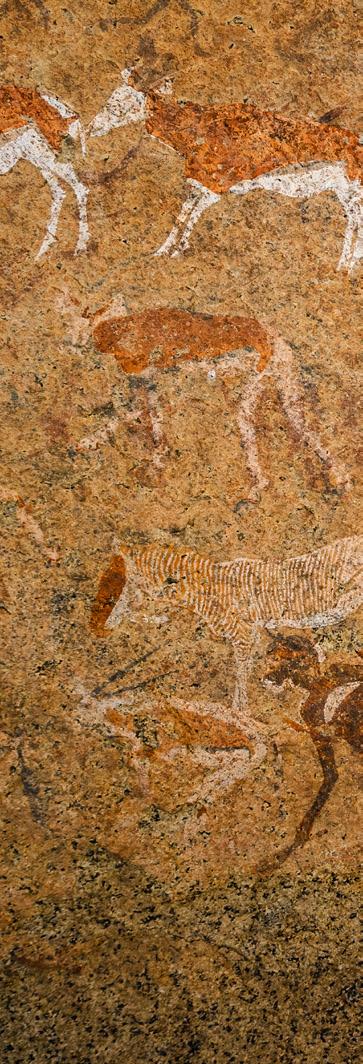
it’s been used as a film location (notably 2001: A Space Odyssey in the “ d awn of Man” sequences). Spitzkoppe feels surreal; a collection of massive granite towers, 120 million years old, that have torn through the desert floor, at odds with the featureless landscapes all around.
There are similar, smaller rocky outcrops in the vicinity that add to the interplanetary feel of the landscape, which is covered in San rock art. A precise, bright red painting of a rhino is one of the most famous images, dating back some 4,000 years. The artist
Are you captivated by the idea of ancient rock art? There's many stories ready to be told in caves and on rocks all over the globe.
Visit Ajanta and Ellora in India where masses of intricate paintings and sculptures line deep, dark caves, engraved into sheer granite cliffs. Taking over 600 years to create, there’s plenty of astounding stories to uncover here.
Cueva de las Manos (cave of hands) in remote Argentina, shows a collage of hundreds of hands that date back as early as 7,300 BC. This artwork was created in relief, by blowing paint through hollowed out bird bones.
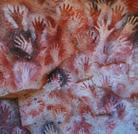
In France, near the village of Montignac, Lascaux Caves houses artwork that’s a similar age to the early San art in Namibia, dating back approximately 20,000 years. In order to protect and conserve the caves, travellers can now visit a tremendous replica, complete with guided explanations.
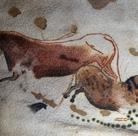
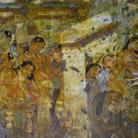
captures the animal's proportions and stance brilliantly, its clarity is surprising.
Namibia’s epic landscapes, and Spitzkoppe in particular, capture the essence of the intricate San story. Being able to share the same view that the San would have gazed upon (albeit thousands of years apart), next to their vivid rock art, learning about their culture and appreciating their treasured land is a meaningful and enlightening experience.
Pack your bags for Namibia
→ jody.vanmerode@jacadatravel.com
Australia’s Kakadu rock art was created by its First Nations. One of the largest and oldest collections of rock art in the world depicting animals, intricate symbols and human figures - some, like Cueva de las Manos, have been stencilled.



In the deep blue waters of the Coral Triangle lives a group of people known as The Bajau. For centuries, these sea-dwelling nomads have called the ocean their home, ultimately earning the title ‘People of the Sea’. We take the plunge and dive deep to learn about their way of life and the unique physical capabilities that make them significantly distinct from any other human being on this planet.
 Words: Beverley Lennon
Words: Beverley Lennon


Ascattering of pristine islands dispersed across both Indian and Pacific oceans, Indonesia is like nowhere else on Earth. This chain of more than 17,000 islands offers unspoiled beaches, crystal-clear waters, smouldering volcanoes and lush jungles, along with a collection of UNESCO Heritage Sites. The country’s ever changing landscapes make it one of the most diverse destinations to explore. But that’s not nearly all.
Indonesia is also an intriguing land of fascinating cultures. It is home to approximately 300 ethnic groups, with more than 700 languages and dialects being spoken across the archipelago. In some of the country’s most remote corners, visitors can come across the world’s last few indigenous tribes. These tiny pockets of people still maintain traditions and lifestyles passed down from their ancestors, one generation to the next.
Uninfluenced by modern civilization, many of these tribes live in ancient rainforests. But some more isolated than others, live away from the comfort of land. This group of people is known as The Bajau; and they call the deep ocean their home. They are born, raised, live and die at sea.
Unlike any other human on the planet, The Bajau are some of the last true wayfarers of the oceans. More commonly known as ‘sea nomads’, these masters of the waters are expert freedivers and have been living in the sea for centuries.
Although the origins of the Bajau diaspora remain unclear, many believe that a mythical event led to the dispersal of the indigenous tribe. Legend has it that when a princess from Johor was swept away by a flash flood and lost in the Sulu Sea, her mourning father commanded his minions to search the ocean and not come back until they had found her.
As a result, those who set out in her pursuit have been wandering the sea ever since and never returned ashore. Instead, they made the ocean their permanent home, adopted a seaborne lifestyle and eventually labelled themselves as ‘underwater hunters’.
With no nationality and no fixed address, the Bajau people are a nation of the sea. To them, the ocean means everything. It’s not only their home or a playground for their children, it is their main source of food and income. Traditionally, they subsist on pelagic fish, pearls and sea cucumbers – an Asian delicacy that is also used in traditional Chinese medicine.
Within their community, men and women have very different responsibilities. That said, both roles are equally crucial to the functioning and survival of their societies. Bajau men are the primary bread-winners. They are responsible for hunting. Every morning, they board their small boats and set off to the deep ocean in search of sea creatures; or tonight’s dinner.
For the success of this mission, they need to be equipped. Handmade wooden goggles and a couple of spear guns made from boat timber, tyre rubber and scrap metal are all they need. Surprisingly, these seem to be adequate enough for their military precision under water.
Women on the other hand, are responsible for childcare and the preparation of food. They start their day by painting their faces with traditional borak paste made from turmeric, which protects their skin from the intensity of the sun. Once the tides go out, they can be seen scanning the shore for shellfish; perhaps their favourite side dish.
When stationary, Bajau families live above the water in stilt houses and lepas (houseboats). From here, men have easy access to the shore, where they
“To them, the ocean means everything. It’s not only their home or a playground for their children, it is their main source of food and income.”


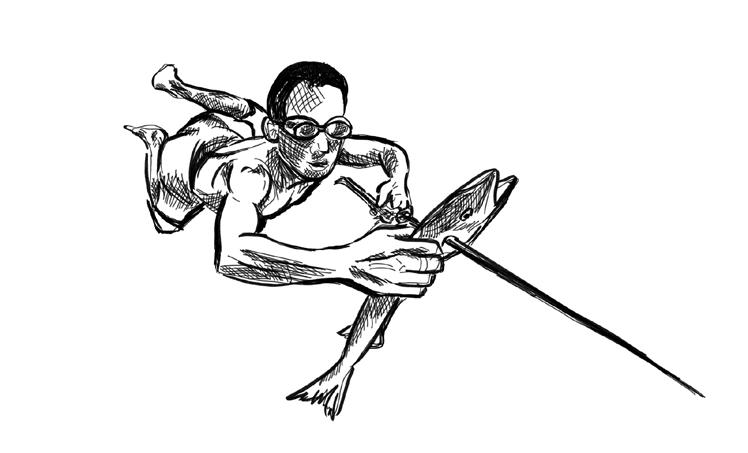


go to trade for supplies, build new boats or to shelter from violent storms. But life on terra firma isn’t one for the Bajau. These real mermen and mermaids only feel whole when they are in their element: the ocean. They report feeling ‘landsick’ whenever circumstances force them to stay on stable ground for too long.
The Bajau people spend approximately 60% of their work day beneath the surface, looking for fish and harvesting other creatures from the ocean floor, all in one breath. dining exclusively on seafood, their lean bodies help them make better use of oxygen, compared to those with more body fat. This means that the Bajau have an impressive ability to hold their breath for a record-breaking time of over five minutes, making it the greatest daily apnea-diving time ever reported in humans. To put things in perspective, that’s longer than any highly trained diver. But how do they do it?
researchers have found that the seafaring Bajau have developed unique genetic adaptations. With internal organs and body capabilities unlike any of us, the Bajau people are able to spend the majority of their days diving and hunting underwater without oxygen tanks or snorkels. In fact, it has been found that they have genetically developed spleens 50 percent larger than their land-dwelling neighbours. This unusual physical feature enables them to adapt to their low-oxygen environments.
Most Bajau children are born at sea. With the ocean being their only playground, they are raised to adapt to their surroundings. Since diving is part of their daily activities and crucial to their aquatic lifestyle, the Bajau deliberately rupture their eardrums at an early age. This way, they are able to dive painlessly. Bajau children also develop traits unlike any other human, such as remarkable underwater vision. They are able to see two times clearer underwater than other children. Swimming and diving are some of the first skills taught to youngsters, training the muscles in their eyes to constrict and let in more light while submerged. In later years, this mastery gives them the advantage of hunting harder-to-come-by sea treasures.
The Bajau today
For many reasons, it is possible that the current Bajau generation could be the last cohort able to sustain themselves on the water. despite being expert fishermen, it is getting harder for them to find fish due to the introduction of marine protected areas within the Coral Triangle. Commercial fishing has also disrupted the fishing traditions and ecosystems of the Bajau people, forcing them to start using other methods.
Today, the Bajau tribe is gaining more exposure to the modern world. Their freedom to move and live anywhere is becoming increasingly uncertain. In the past decades, controversial government resettlement programmes have led to the Bajau living under extreme economic, social, and political pressure.
Without a nationality, the Bajau children aren’t recognised citizens and therefore do not have access to adequate healthcare and education. By lack of choice, many Bajau families have given up their sea-based life and moved to coastal cities, ditching their centuries-old traditions for the future of their children. Their citizenship hangs in the balance.
But there is still hope. Many of the Bajau cling to their local wisdom and refuse to give up their way of life. Perhaps the most fundamental lesson we can take from them is the ability of humans to live in peace with their environment. For the Bajau, the ocean is sacred, both for spiritual and material survival. They believe that spirits inhabit the sea, that the ocean is the dwelling place of their gods and that the bounty of fish is their gift.
With more marine species than anywhere else on Earth, the Coral Triangle is often described as ‘the Amazon of the ocean’. Spanning Indonesia, Malaysia, Papua New Guinea, the Philippines, the Solomon Islands and Timor-Leste, this underwater wonderland plays host to more coral reef species than anywhere else on Earth.
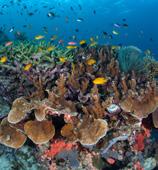
Its vast collection includes 15 endemic coral species – types that are unique to the region. These beautiful reefs are teeming with fish and welcome seasonal visitors such as smaller sperm whales, dolphins, and porpoises. Add to this six of the world's seven marine turtle species - many of which are of interest from a conservation perspective.
Go on an epic expedition, sail the waters of Indonesia onboard a luxury yacht.
→ ellie@jacadatravel.com

This is India: a land whose story can best be told through the diversity of its people and the richness of its culture. Comprising a sumptuous mix of traditions, this nation of many colours is steeped in spirituality. It’s a country of contrasts, a country of rituals and the holy home of the Sadhus…

Draped in deep hues of orange and saffron, the Naga Sadhus of India (often referred to as just “Sadhus”) are followers of Lord Shiva. They’re ascetics who live a life of aparigraha: the practice of non-attachment and the art of letting go. While modern society seems to be stuck in the trap of consumerism, the Sadhus lead a blissful life with as few material possessions as possible.
Characterised by extreme self-discipline, the Sadhus restrain themselves from all forms of indulgence. They believe possessions only take up space and energy, so they let go of their clothes, food, home and family. After detaching themselves from earthly belongings, India’s holiest men embark on a spiritual quest of knowledge and devotion.
Tradition dictates that an aspiring Naga Sadhu must follow a set of rules and rituals. Before leaving his family and society, he needs to perform his own funeral rites – pind daan and shraddh. This is due to the belief that only after one is considered dead by his family can he be relieved from all moral responsibility as a man. This act marks his birth into a new world, granting him a new name and identity as a Naga Sadhu.
In order to prove their devotion to God, the Sadhus abstain from mental, bodily and material pleasures. They practise this detachment by remaining naked and staying as natural as possible. On the rare occasions when they appear in public, they wear loincloths to cover their genitals. To avoid temptation, a Naga Sadhu is required to be celibate while gaining complete mastery over his emotions, lust and sexual desires.
Upon renouncing material wealth, Sadhus further detach themselves by moving away from their cities and villages to live in some of India’s most remote corners. For most of the year they stay in isolated caves or ashrams among the snowy peaks of the Himalayas, where they can only sleep in direct contact with Mother Earth. Forgoing the use of a couch, bed, mattress or quilt, they rest at one with nature.
Unsurprisingly, Naga Sadhus lead very simple lives. One of their many sacred rituals involves covering themselves with human ash – the last rite of the material body. This symbolises their renunciation of worldly objects of pleasure, such as jewellery and other accessories. The sacred ash, or bhasma, is collected from the holy cremation ground in Varanasi, the spiritual capital of India.
To attain enlightenment, the Sadhus combine the practice of yoga with the use of hash, or charas, in order to find inner peace and inspiration. Charas, the ‘black gold of the Himalayas’, is considered one of the region’s greatest treasures. When consumed, it produces immense
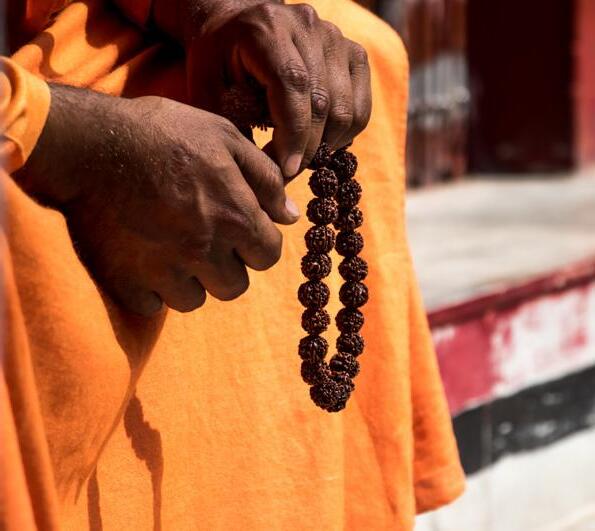
“After detaching themselves from earthly belongings, India’s holiest men embark on a spiritual quest of knowledge and devotion.”
Right. Saffron, the colour of the sunrise/sunset (sandhya) and of fire (agni), is of great mythological significance to Hindus. By wearing saffron robes, the Naga Sadhus hope to attain a life of purity and abstinence.
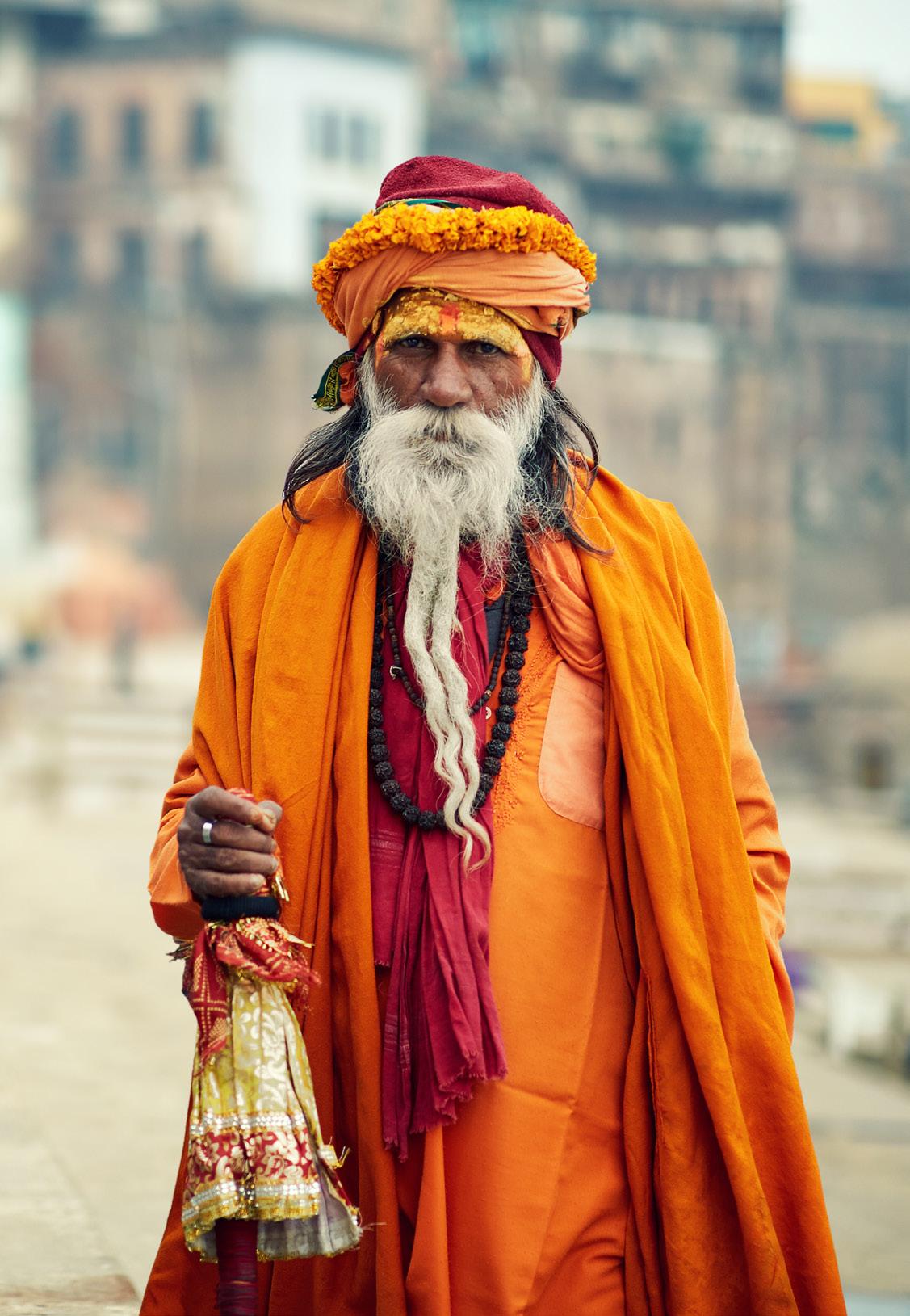
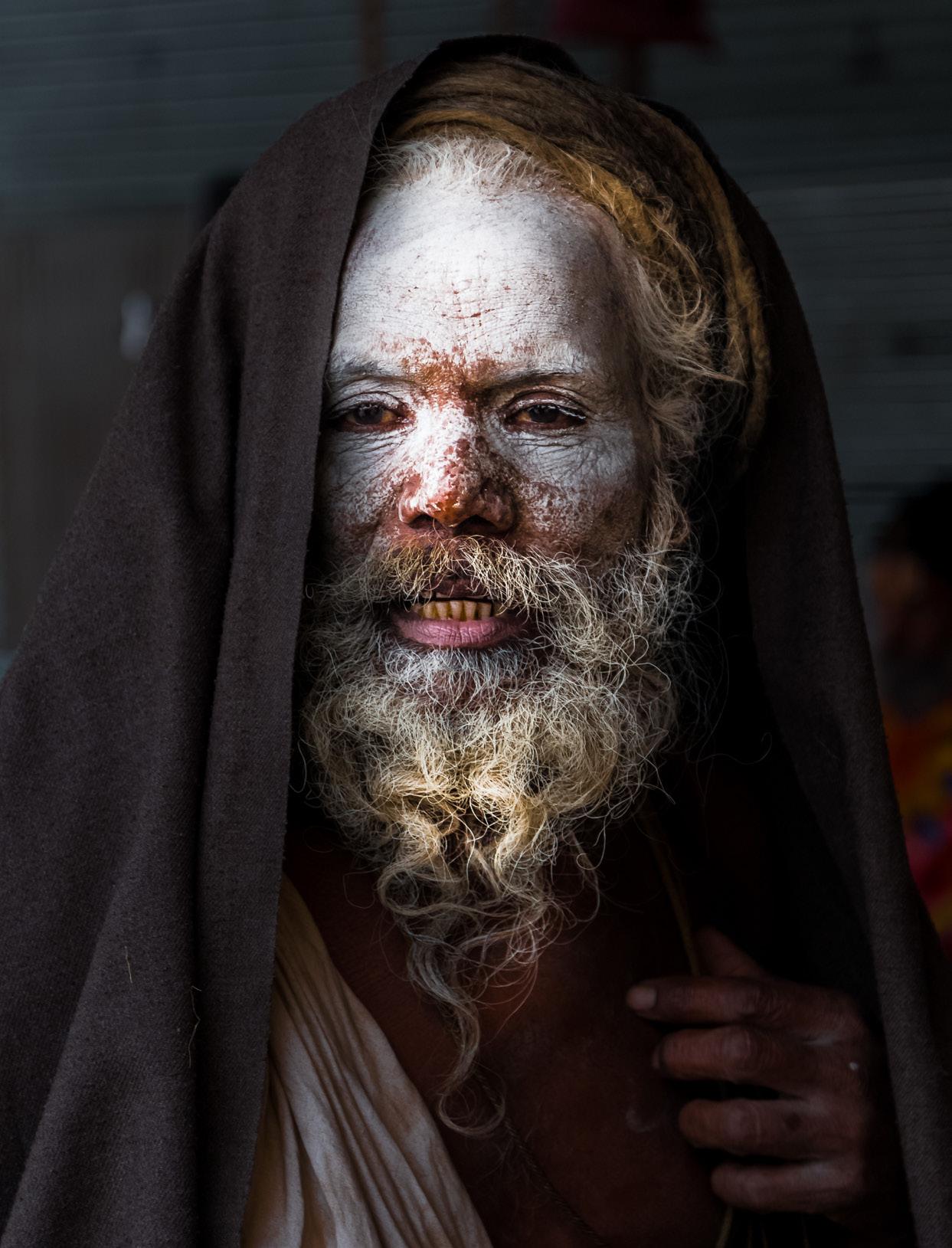 Left. According to Naga Sadhus, covering their faces and bodies with sacred ash from the cremation grounds can help them to achieve moksha.
Left. According to Naga Sadhus, covering their faces and bodies with sacred ash from the cremation grounds can help them to achieve moksha.
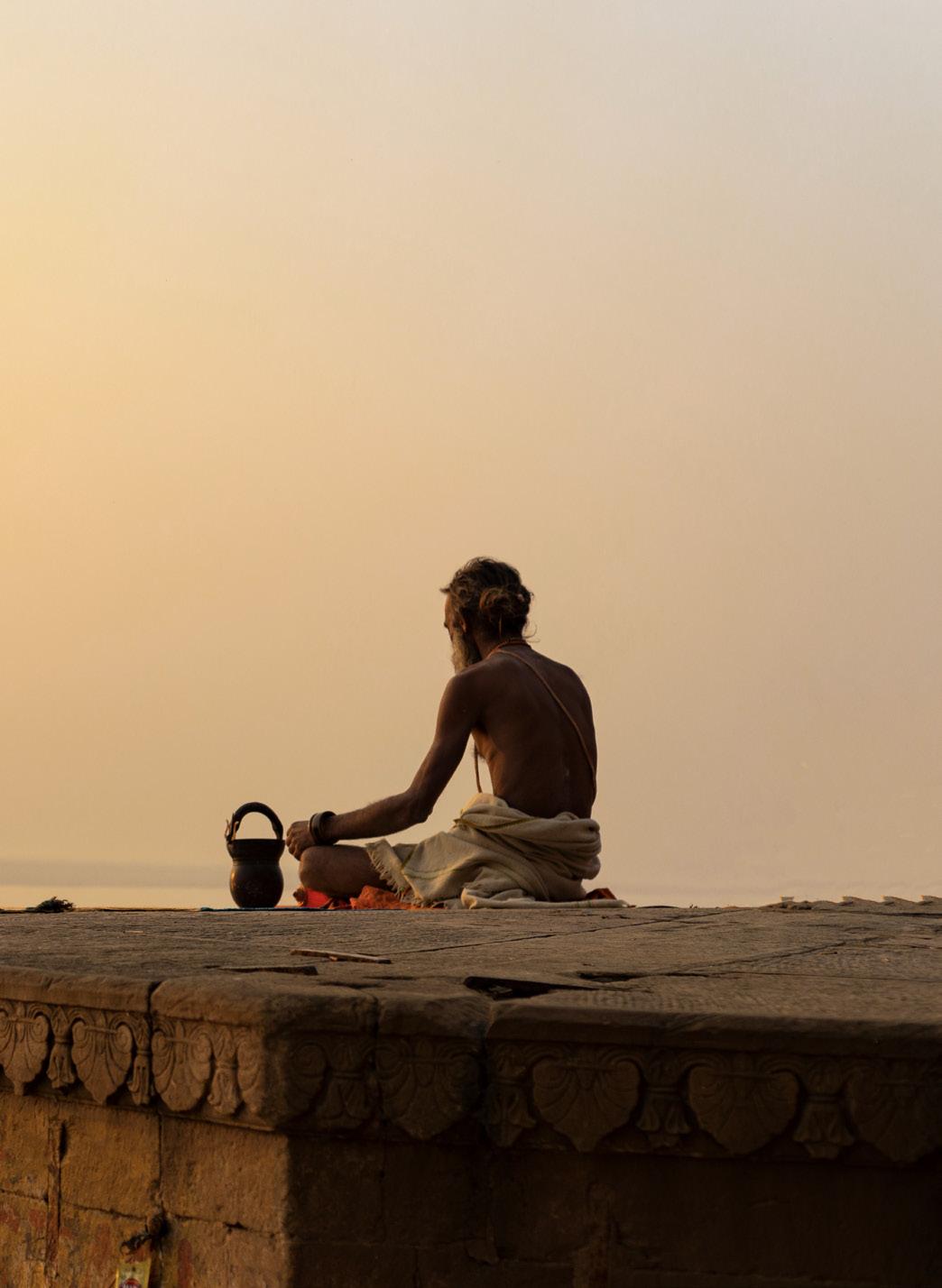
amounts of heat in the body, helping the Sadhus to cope with the extremely cold temperatures of the mountains.
According to their strict regime, the Naga Sadhus can only eat once a day. Most of them are vegetarian. When in the mountains, they feed on what nature provides: root vegetables, fruits and herbs. While staying in the villages, they depend entirely on the kindness and donations of strangers. It’s said that a Sadhu can only beg for food in a maximum of seven houses. If they aren’t offered anything, they won’t eat for the rest of the day.
Hindus believe that a person’s soul goes through a cycle of successive lives. This never-ending process of rebirth is referred to as samsara. Each individual’s next incarnation is dependent on how they lived their previous life. For this reason, they take care to behave in a way that will provide good karma in this life and the next.
According to Hinduism, the purpose of life is to achieve four goals. These aims are referred to as purusharthas, and include dharma (morality), artha (wealth), kama (emotional fulfilment) and moksha (liberation). As they’re considered to be sacred entities, Naga Sadhus are solely dedicated to achieving the fourth and final goal: moksha.
Moksha is regarded as the final release from life’s illusion, and is achieved by overcoming desires through the mastery of self-discipline. It’s also believed to represent liberation from the cycle of birth and death. To achieve this life goal, Sadhus and other devotees gather to take part in the world’s largest religious gathering, the Maha Kumbh Mela.
The Kumbh Mela
Nothing can quite prepare you for the Kumbh Mela. Offering a dizzying array of sights, swirling colours, captivating sounds and traditions, this event is a true feast for the senses. It pulses with vibrant energy, intriguing the mind and awakening different emotions all at once.
d uring this devotional celebration, millions of believers bathe in India’s most sacred rivers, including the Ganges, in order to achieve moksha. Participation in the magnificent event promises an eternal life free of sins.
The regular Kumbh Mela is held every three years; the Ardh (half) Kumbh Mela every six years; and the Purna (complete) Kumbh Mela every twelve years at four different places, all based on planetary movements. But the Maha Kumbh Mela, the biggest celebration, only takes place at Prayag every 144 years (or twelve Purna Kumbh Melas). The event’s scale and significance have earned it a place on UNESCO’s list of Intangible Cultural Heritage.
The Kumbh Mela is the largest human gathering on earth, and the only occasion where one can observe the holy men of India. Emerging from their distant abodes in caves and mountains, all of the country’s Sadhus and gurus congregate in one place.
The spiritual capital of India
Varanasi is not only the city of Lord Shiva and one of the oldest inhabited cities in the world – it’s also an authentic window to the real India. As the epicentre of Hindu faith, every bit of this region is sacred, soulful, seductive and, above all, spiritual.

To understand the country's amazingly diverse and enchanting culture, early-rising visitors are invited to embark on a sunrise boat ride on the magnificent Ganges river. Known locally as the Ganga, this is more than just a river; it’s a sacred entity and a giver of life, with incredible healing powers.
There’s a timeless connection between Indians and the Ganga. Pilgrims come here to immerse themselves in the holy waters and purify their sins, but also to cremate their loved ones, do their laundry, cleanse the soul and heal the body… It’s truly the lifeblood of India.
“Varanasi is not only the city of Lord Shiva and one of the oldest inhabited cities in the world – it’s also an authentic window to the real India.”
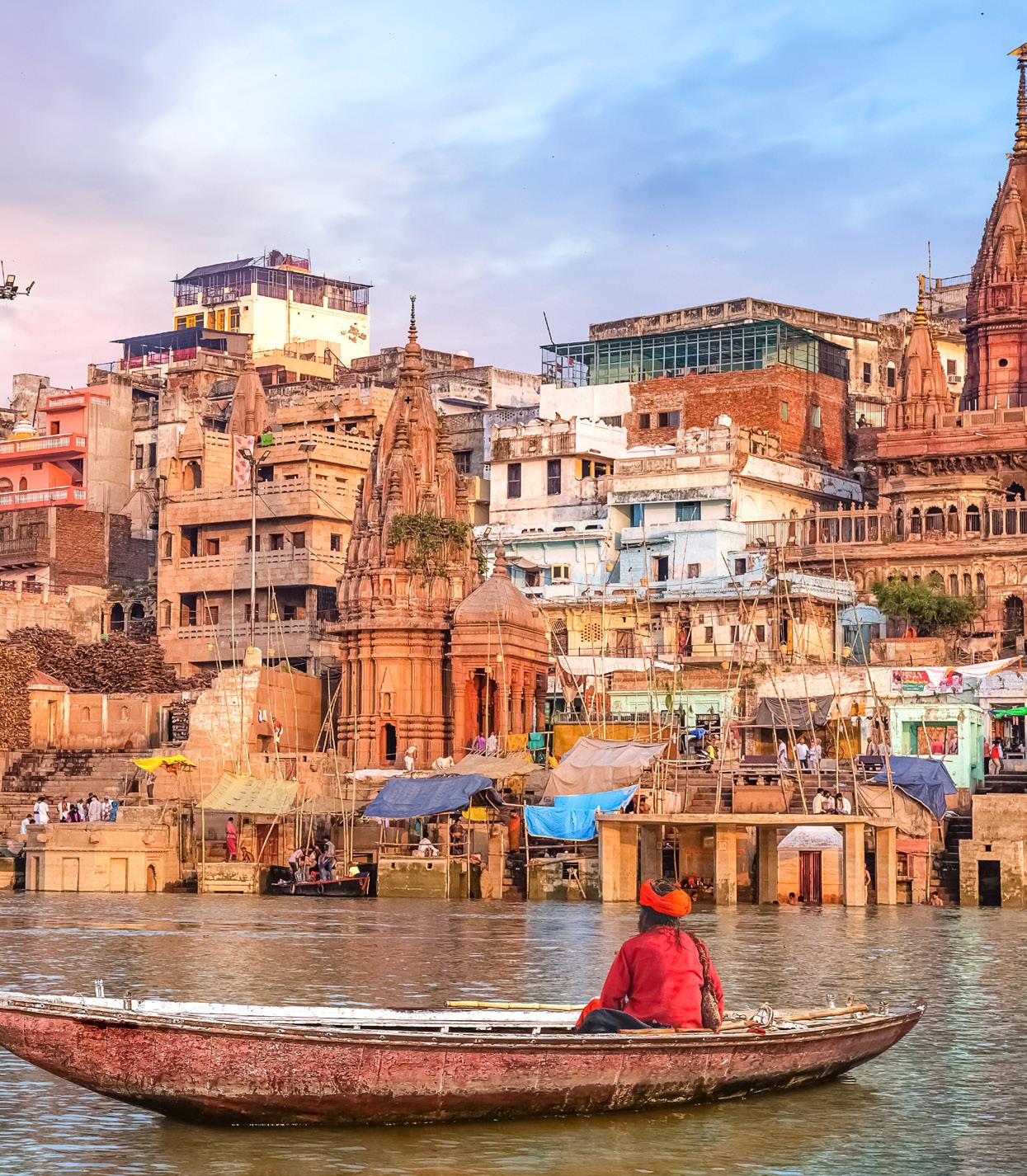

Breathtaking icy landscapes, endless dramatic coastlines, captivating cities and a laid-back lifestyle - there’s an alluring collection of beautiful Scandinavian countries. However, step back in time and discover the terrific, sometimes terrifying, stories and beliefs behind Scandinavia's Old Norse mythology.
Words: Terri dunbar-Curran
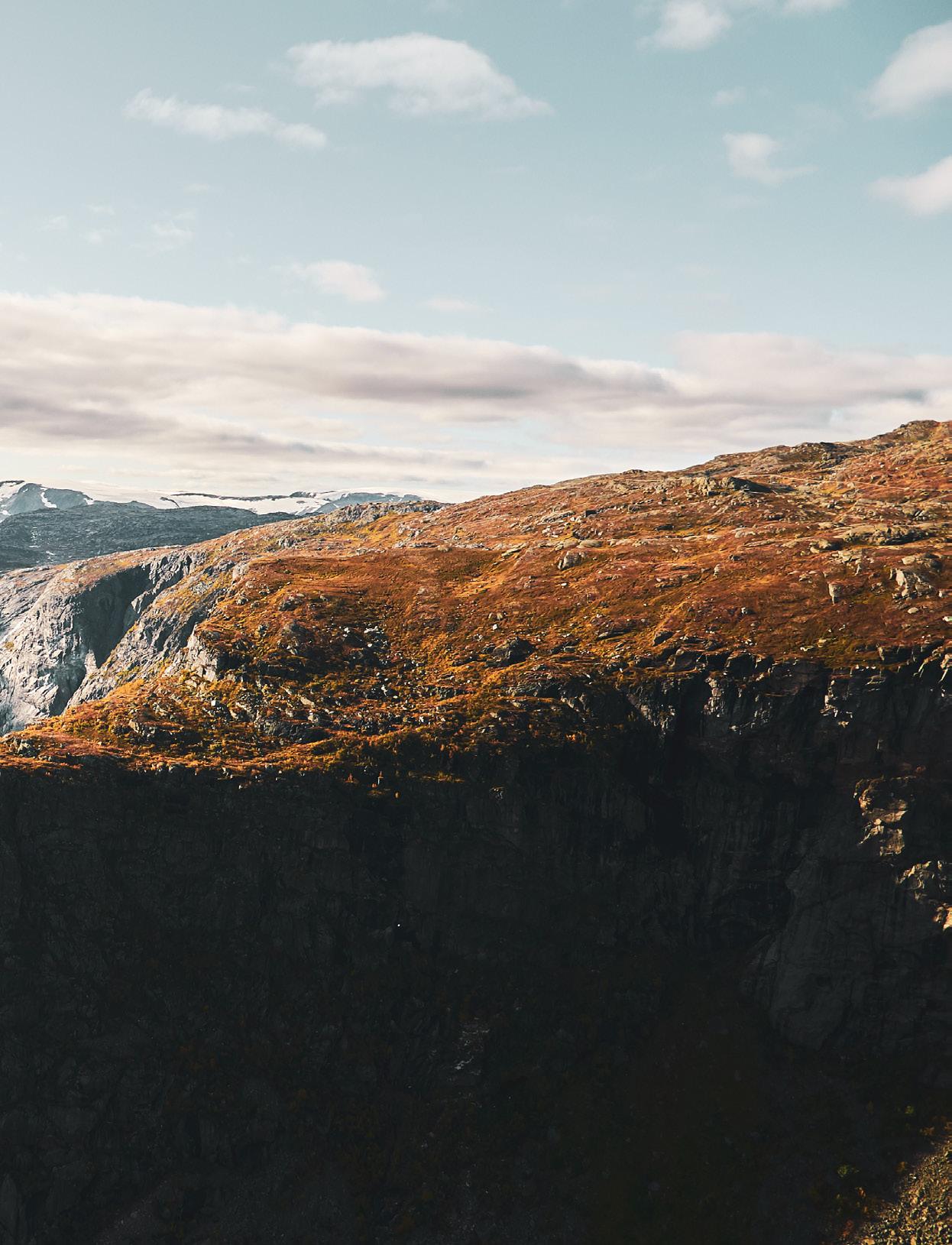
Seafaring warriors who voyaged across large parts of Europe in their longships; Vikings have found a permanent place in modern popular culture. Beyond the debates over just how extreme their way of life may have been, there’s a rich mythology that runs through this ancient culture.
Norse mythology dates back to the Viking Age (c. 790 - c.1100CE). This is a collection of myths and stories, belonging to the North Germanic people of Scandinavia, which have their roots in Old Norse religion. They survived the arrival of Christianity and gradually became the folktales we know today.

Most belief systems have a creation-story and Norse mythology is no different. Legend has it that before
time began, the frozen land of Niflheim and the fiery land of Muspelheim clashed and in the confrontation the frost was turned to water. From those drops of water came the giant Ymir who was killed by Odin, God of Wisdom, Poetry and War, and his brothers. His body parts became the building blocks of the universe, all supported by Yggdrasil, the World Tree.
For every beginning, there is an end, and in Norse mythology this end, ragnarök, is brought about by a series of catastrophic events. It will all culminate in an epic battle between the gods and other beings, bringing the deities to an eventual end.
The one-eyed Odin is the head of Norse mythology’s polytheistic pantheon, with all the gods and goddesses
Left. Norway’s stunning Borgund Stave Church showcases a combination of Christian motifs and Viking architecture. It is believed that the church was built by the same people who put together Viking longboats.
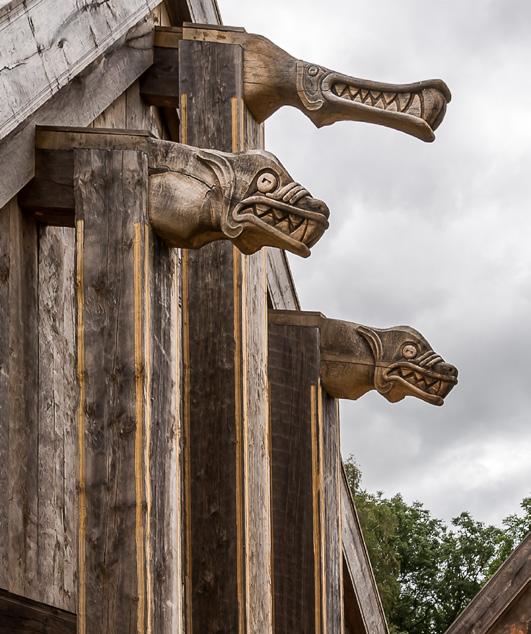
harvest celebrations. On land, he travels in a chariot pulled by the boar Gullinbursti and sometimes on the boar itself, and by sea he sails on his ship Skíðblaðnir which can be folded up and stored in a small bag.
The Norse gods reside in Asgard, humans live in Midgard (Earth), and those warriors who die in battle may find their place in Valhalla alongside Odin until ragnarök.
therein belonging to two major clans: Æsir and Vanir. Numbering more than 66 in total, the main Æsir deities are Odin, Frigg, Thor, Loki, Balder, Hod, Heimdall and Tyr, and the most notable Vanir gods are Njord, Freyr, and Freyja. The ancient Scandinavian people venerated these gods through customs that formed an integral part of daily life.
Odin, who traded his one eye for wisdom, is widely associated with war and death. He gathers fallen warriors in Valhalla and meets his end beneath the wolf Fenrir in ragnarök. Thanks to his popularity across a vast range of sources, some of the mythology around him is complex. For instance, it is believed that his status as the Allfather may have only surfaced later as a result of Christian ideology.
Thor, the hammer-wielding god, was associated with incredible strength and a kindness towards humankind. It’s not unusual to see depictions of his hammer Mjollnir carved on ancient stones and near tombs. Thor and his enemy Jörmungand, the world serpent, are destined to kill each other in ragnarök.
Freyr, god of peace and fertility, was worshipped in Sweden, and also across Norway and Iceland, where it was believed their prosperity depended on his benevolence. Sacrifices were made to Freyr at weddings and

Besides the gods and goddesses, Norse mythology is full of fabled creatures and monsters who interact with, challenge and often defeat the very gods themselves. delve into the stories and you’ll encounter the likes of elves, dwarves and giants. That said, while the word jötnar is often translated as giants, they are thought by many to have actually been human-sized. The gripping tales also tell of valkyries and the enormous Kraken (which you can read more about in our Sea Monsters feature on page 54).
Thor’s enemy Jörmungand, the massive Midgard sea serpent that encircles Earth, is the child of Loki and the jötunn Angrboða. r agnarök begins when it releases its grip on its own tail. Another of Loki’s children is Fenrir, an extremely vicious wolf who, as a
“Besides the gods and goddesses, Norse mythology is full of fabled creatures and monsters who interact with, challenge and often defeat the very gods themselves.”

result of biting off the hand of the god Tyr, is destined to remain gagged with a sword and bound to a rock until ragnarök. Before swallowing Odin, Fenrir will devour the sun.
With the widespread publication of Old Norse texts in the 19th century, many of the lesser-known stories came to the world’s attention, spreading out from Scandinavia to Germany, Britain and beyond. As the 20th century progressed, it quickly became a recurrent theme in science fiction, fantasy literature and even Japanese animation.
The ancient art of storytelling was pivotal to Norse mythology in the early days, and it could be said that even with modern technology and our ever-changing media, it remains so, albeit in a different form.
Apart from its enduring presence in popular culture, Norse mythology still plays an important role in Scandinavia today. There is a group of between 500 to 1000 people in denmark who practise Ásatrú, the worship of the ancient Norse and Germanic gods. It’s interesting to note that the vikings did not have a name for their religion until Christianity was introduced to them. Only then did they start referring to it as ‘the old way’, as opposed to Christianity which was ‘the new way’.

The Ásatrú movement was started in the early 1970s when a group of Icelanders decided to revive public worship of the gods, goddesses and spirits. As such, it’s not a strict continuation of the beliefs of the vikings, but rather a reinterpretation of the old religion.
From historic texts, to big screen blockbusters, epic poetic sagas and time-worn carvings, the world of Norse and Viking mythology is endlessly fascinating and complex. While we may never grasp it in its entirety, one thing is for certain, it will inspire and captivate humanity for many more generations to come.

"There is a group of between 500 to 1000 people in Denmark who practise Ásatrú, the worship of the ancient Norse and Germanic gods."
Head out on your own viking-inspired adventure. Our team of expert travel designers can help bring the world of Norse mythology alive for you.

Denmark:
In Copenhagen you can visit Lejre, a beautiful open-air museum where you can wander through a village of reconstructed houses and active workshops from different times through history, including the Viking age.
Head to the Faroe Islands where you can take a walk through the old part of one of the smallest capitals in the world, Tórshavn. You'll get to see Tinganes, the world's oldest parliament. The name Tinganes means "parliament jetty", and it was first used as a meeting place in Viking times. Also in the Faroe Islands you’ll find the small Viking village of Bøur. Here you can meet with a farmer and learn about life in the village both now and in days gone by.
Norway:
The Viking village of Njardarheim is located in Gudvangen, at the end of the Nærøyfjord. Spend some time chatting to the people who live nearby, learn about the past and even take part in some Viking games and activities.
In Tromso, you can ride on a buggy and walk through a forest to find a hidden Viking house. Here your hosts will share stories of Viking times while tucking into a home-made meal. And if you’re up to the challenge you can participate in an axe-throwing competition.
Head to Gimsøy Island in the Lofoten Islands and take a ride on Icelandic horses across white beaches and past a variety of ancient remnants of the Viking age.
As our interest in and understanding of ancient cultures deepens we’re continually uncovering new information and learning more. In fact, as recently as two years ago, a 1,200-year-old pagan temple was unearthed near the village of Ose in Norway. Believed to have been built centuries before Christianity arrived, the temple was dedicated to gods like Odin and Thor.
Archaeologists say that the remains of the large wooden building, or ‘god house’ dates back to the eighth century and would have been used especially during midsummer and midwinter solstices. Based on the positioning of the round post holes and other artefacts discovered in the area, they were able to get a fairly accurate picture of how the temple would have looked way back then.
Immerse yourself in culture and history → jacadatravel.com/arts-culture-and-history/
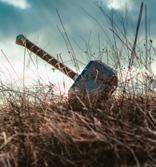

Marvel Universe: Thor and Loki are prominent figures in comic books and screen adaptations. You’ll also spot Odin, Freyja, Brunnhilde, Heimdall, Hela, Balder, Sif and Fenrir.
Neil Gaiman's Sandman: Odin, Thor, Loki, and several other beings put in appearances in the graphic novel series.
Hajime Isayama’s Attack on Titan: This Japanese manga series has prominent themes of Norse mythology.
Vikings TV series: The Canadian series is based on the viking ragnarr Loðbrók and references gods like Odin, Thor, Freyr and Loki.
American Gods TV series: An adaptation of Neil Gaiman’s novel featuring a variety of figures from Norse mythology.
Assassin’s Creed: Valhalla: This video game is strongly based on Viking history and Norse mythology with story arcs set in Asgard and Jotunheim.
do you believe in monsters? If so, you’re not alone. All across the globe, legends tell of mysterious creatures who inhabit the underwater world. Some resemble serpents or other familiar forms, while others seem to have leapt straight out of a nightmare. But all of these aquatic beasts have one thing in common – they never fail to fascinate us.

From ancient folklore to modern internet theories, sea monsters have always had a way of capturing our imagination. They’ve inspired people to spend hours scanning lakes for ripples of evidence, and to pore over grainy video footage trying to prove – or disprove – their existence.
Whatever side of the debate you find yourself on, there’s something undeniably intriguing about the origins of these underwater beasts and the beliefs connected to them. Almost everywhere you go in the world, there are legends of creatures living in the murky depths… and we’ve dipped beneath the surface to uncover a few of them for you.
The Lake Tianchi Monster was first described as a large buffalo-like creature living in Heaven Lake, a volcanic crater atop China’s Baekdu Mountain. More recent reports say it has a human-like head, smooth grey skin and a five-foot-long neck with a white ring at its base.
When the monster was spotted for the first time in 1903, it reportedly attacked three people and was shot six times before disappearing back into the depths. Fast forward almost 60 years, and two of the creatures were apparently seen chasing one another, with more than 100 people reporting sightings.
As recently as 2007, a TV reporter captured 20 minutes of video footage of six strange creatures swimming in the lake. In his account, the creatures resembled seals with exceptionally long fins (or possibly wings). researchers suspect that these ‘monsters’ could actually be the mutated offspring of trout that were introduced into the lake decades ago.
Many people believe that humanoid aquatic reptiles called kappa lurk in the lakes and ponds of Japan. About the size of a pre-teen child, kappa are green and scaly with webbed hands and feet, and a sort of shell on their backs. They serve as a warning to children to stay away from the water – you’ll even find signs alerting you to their presence in some towns and villages.
Sometimes kappa are credited with harmless mischief, but other times they’re incredibly hostile. They’re often blamed for drowning people, and some believe they drain their victims’ blood. If you want to placate them, make sure you have some cucumbers – their favourite food – on hand. Offerings of cucumber are even made to the kappa at festivals.
If you’re unlucky enough to be cucumberless when confronted by one, you can appeal to their obsession with
politeness by bowing deeply. As they bow back, the waterfilled indentation on their head will empty out. Legend has it that the creature will remain stuck in a bowed position until this hollow is refilled with water from the river where they live. If you do this for them, you’ll have a loyal servant for life.
Phaya Naga – Mekong River, Laos
It’s not unusual to see statues of the Phaya Naga in front of temple gates in Southeast Asia. These serpent-like beasts are said to protect the communities around the Mekong river, where they live.
Sometimes depicted with multiple heads, Naga not only protect the people of Laos, but they also control the waterways – and are therefore responsible for making the country’s soil fertile. Special ceremonies are held to give thanks to the creatures, as failure to honour them could supposedly result in floods, crop failure and illness.
Every year at the end of Buddhist Lent, massive crowds gather at the Mekong river to watch the Naga breathe fireballs into the sky. This annual event is known as Bang Fai Phaya Nak, and is believed to be the Nagas’ way of requesting Buddha’s return. Many have tried to find a more logical explanation for the strange glowing orbs, but the legend lives on.
Mokele-Mbembe – Congo Basin, Democratic Republic of the Congo rumours of massive beasts in the Congo region date back to the 16th century, but the idea of MokeleMbembe only really took hold in the 20th century. This famed creature is said to live in the Congo Basin and resemble a brontosaurus. Its name means ‘one who stops the flow of rivers’ in the local Lingala language.
Much of the evidence for the existence of this ‘living dinosaur’ is based on the speculations that zoologist Carl Hagenbeck published in 1909. His musings were inspired by discoveries of dinosaur bones, and further fuelled by rumours and media attention.
Some locals also tell stories of the creature, helping to keep the legend alive. despite over two dozen attempts to track it down, there’s no photographic or video evidence to prove that Mokele-Mbembe exists – but the search will no doubt continue.
“Researchers have recorded mysterious sonar readings that seem to suggest large creatures living in the lake, although they haven’t been able to capture or identify them.”
Ninki Nanka – Gambia River, Gambia
This dangerous dragon-like creature is thought to live in the rivers and swamps of West Africa. Word of the Ninki Nanka has been passed down through the generations, and it often plays a role in cautionary tales to keep children away from the swamps. Apparently, coming face-to-face with it almost always results in death.
The only way to kill the Ninki Nanka is to force it to look upon its own reflection – so if you find yourself in the vicinity of the Gambia river, you might want to carry a mirror. A 2006 expedition of ‘dragon hunters’ from the Centre for Fortean Zoology turned up several accounts from people who claimed to have seen the monster… but no direct evidence.
Adamastor – Cape Point, South Africa
dreamt up by Portuguese poet Luis de Camões in his 1572 epic poem Os Lusiadas, Adamastor supposedly has roots in Greek mythology. In Camões’ tale, sea goddess doris banished the giant to the Cape of Good Hope after he fell in love with her daughter. He came to represent the cape (which was originally called the Cape of Storms), and was known to emerge from the clouds to protect his domain from explorers.
The poem reads ‘… an immense shape materialised in the night air, grotesque and enormous stature with heavy jowls, and an unkempt beard, scowling from shrunken, hollow eyes, its complexion earthy and pale, its hair grizzled and matted with clay, its mouth coal black, teeth yellow with decay’.
In the story, Portuguese explorer Vasco da Gama is brave enough to confront Adamastor, who eventu -
ally relents and lets him pass. Today there’s a statue of the menacing monster at Lisbon’s Miradouro de Santa Catarina, snarling down from a rough-hewn stone pedestal.
Selma – Lake Seljord, Norway
Norway’s Lake Seljord is said to be home to a legendary sea serpent named Selma. With more than 100 reported sightings since 1750, it’s no wonder that the creature takes centre stage in Seljord’s coat of arms. Although reports vary, it’s generally likened to an enormous anaconda, possibly with humps on its back like the Loch Ness Monster.
The oldest account told of a creature attacking the boat of Gunleik Andersson-Verpe as he was rowing across the lake. Over a century later, another report claimed that a young boy and his mother killed a ‘strange-looking lizard’ on the shore. And as recently as 2001, a father and son from Oslo witnessed what they described as a giant snake, which they initially mistook for a log or old car tires, at the water’s edge. researchers have recorded mysterious sonar readings that seem to suggest large creatures living in the lake, although they haven’t been able to capture or identify them.

Loch Ness Monster – Loch Ness, Scotland
Loch Ness, in the Scottish Highlands, is allegedly home to one of the most well-known sea monsters in the world. The Loch Ness Monster first gained global
attention in the 1930s, but reports of a strange creature in the region date back much farther than that.
‘Nessie’, as she’s affectionately called, can be traced all the way back to the sixth-century Life of Columba by Adomnán. The text tells the story of a man who was mauled and drowned by the beast, and how St Columba miraculously made it retreat.
The Loch Ness Monster is believed to be a large, long-necked creature with humps on its back that protrude above the lake’s surface. Many consider the sightings and evidence of Nessie’s existence to be simple mistakes or even outright hoaxes. But it’s hard to visit the loch without spending at least a little while scanning the water for a glimpse of her.
The Kraken is a legendary monster believed to reside in the ocean off the coast of Norway. In the mid-18th century, Norwegian bishop Pontoppidan characterised the creature as an enormous octopus known for attacking ships at sea. Having first surfaced in ancient Scandinavian folklore, the Kraken has since found its way into myths, superstitions and fiction.
According to Pontoppidan, the monster attracts and feeds on large quantities of fish. Norwegian fishermen’s lore warns of accidentally snagging it with a hook; the only way to escape its clutches in this case would be to say its name out loud. But even after sending it back to the deep, sailors should be wary of the powerful whirlpool left in its wake.

Although stories of the kraken might sound farfetched, they could be based partly in fact. Some have
posited that the legend was inspired by encounters with giant squid, which can grow to be several metres long. Others point to the possibility of a now-extinct cephalopod that might’ve been even larger.
Yacumama – Amazon River, Peru
Yacumama means ‘mother of water’ in Quechua – an indigenous language spoken in the Peruvian Amazon, where this creature is said to live. resembling an enormous serpent, the Yacumama will supposedly emerge from the water to devour anyone who ventures too close to it. Locals have been known to blow a conch horn before entering the water, as this will make the monster appear if it’s nearby.
One local story tells of a fisherman who discovered a hidden lake deep in the rainforest. As he searched its surface for a place to cast his net, an enormous serpent suddenly emerged. He only escaped because as he was running away, four tapirs fell from the sky and distracted the monster. After this encounter, the Yacumama ventured out and began to roam the rivers.
The glacial Lago Lacar in the Andes Mountains is reportedly home to El Cuero, a creature that sucks the blood from its victims with its snout-like mouth. It’s said to be shaped like a hairless, splayed cow hide – hence its name, which means ‘hide’ or ‘leather’. Its eyes protrude from its head on red stalks, and its body is lined with razor-sharp claws.
There are no documented sightings of the beast, but there is a story that’s been passed down through local families. It tells of a mother who was washing clothes in the Huahum river when her sleeping baby was stolen from her by a large stingray-like creature. Similar tales are common throughout Argentina and Chile, and El Cuero is often compared to the vicious Hueke-Hueke (another legendary lake monster of the region).
Hawkesbury River Monster – Hawkesbury River, Australia
This monster allegedly resides in the Hawkesbury river in New South Wales, Australia. Images of it can be found in Aboriginal rock art several thousand years old – so it’s certainly not a modern creation. It’s called the moolyewonk or mirreeular in local indigneous languages, and is said to have a seal-like head at the end of a long neck, flippers and an eel-like tail.
When settlers arrived to this area in the 1800s, they were told stories of the monster attacking local women and children. But there have also been plenty of sightings in the last century, with reports of large reptilian creatures increasing in the 1980s. Over the years, the Hawkesbury river Monster has been blamed for boating accidents and various other incidents.
Muldjewangk – Murray River, Australia
Yet another creature used as a cautionary tale for children is the Muldjewangk, a water beast from Ngarrindjeri mythology believed to inhabit Australia’s Murray river. Its exact form is a bit murky, and it’s not clear if there’s just one Muldjewangk or many. They’ve been depicted as enormous creatures, half man and half fish – sort of like sinister merfolk – and are thought to hide beneath clumps of floating seaweed.
One legend tells of a European steamboat that was attacked by a Muldjewangk, and how the captain decided to shoot it despite the warnings of Aboriginal elders on board. Soon the man developed red blisters all over his body, and six months later he died a painful death. It’s not hard to imagine why local children would be scared enough to avoid the river after dark.
The Taniwha are large supernatural creatures from Māori mythology, which may be either peaceful guardians or predatory beasts, depending on whom you ask.
Imagine a whale-sized lizard with huge spines along its back, and you’ll have a pretty good mental picture of this monster. They’re said to lurk deep in the ocean and rivers, or in the inky darkness of caves.
Apart from their interactions with humans, Taniwha are apparently capable of tunnelling through the earth, sometimes creating harbours in the process. According to legend, the branches of Hokianga Harbour were carved out by the 11 sons of a Taniwha called
Araiteuru. Some say that Wellington Harbour was also the work of two such creatures.
Like many other sea monsters, the Taniwha could be inspired by a very real animal; in this case, the saltwater crocodiles that occasionally cross the strait from Australia to New Zealand.
Ningen – Antarctica
Stories of the Ningen only surfaced in the 21st century, making this one of the most modern sea monster myths. Japanese internet users started spreading awareness of it around 2012, describing an enormous creature that has both humanoid and whale-like qualities. It supposedly lives in the subantarctic oceans.
The original story is that people on board a whale research ship saw something strange emerge from the water off the Antarctic coast. At first they thought it was a submarine, but then it seemed to be alive. Unfortunately, it disappeared before they could get a closer look.
There’s also a famous Google Earth image that some consider to be photographic evidence of a Ningen, but sceptics say it’s just a monster-shaped iceberg. And in 2010, video footage from a Japanese ocean research team showed a mysterious creature that could either be the monster or – if you’re more scientifically minded – simply a snaggle-toothed snake eel.
See the world’s sea monsters for yourself
From South Africa and the Scottish Highlands to the Peruvian Amazon and Antarctica, our team of expert travel designers can craft a thrilling trip for you. All you need to bring is a pair of binoculars, a camera and a keen eye, and who knows – you might just be the next person to spot one of these mythical beasts.
“Researchers have recorded mysterious sonar readings that seem to suggest large creatures living in the lake, although they haven’t been able to capture or identify them.”

If you wander the narrow, cobbled alleyways of Edinburgh's Old Town after dark, be prepared to encounter some of the city's spookiest residents. There’s no doubting that these streets have a story to tell.


Words: Emelie Stevenson
Edinburgh is a beautiful city, sometimes known as ‘the Athens of the North’. Classical revival architecture and a history as the home of philosophers and academics, mean you’d be forgiven for only focusing on its spellbinding charm. Come evening, however, the looming shadows, narrow alleys and imposing buildings hint at another, darker past.
It’s a time when every visitor has a choice - stick to the grand spaces and inviting lights of the New Town, or venture into the Old Town to discover the other side of the city.
The Old Town of Edinburgh is well over 1,000 years old. The royal Mile sits at its heart, stretching between two royal residences: Edinburgh Castle and Holyrood Palace. Nowadays the street is a bustling, spirited centre for shops and cafes, bars and street performances. Branching off are the iconic Closes, narrow alleys with names referencing their original uses or residents.
These streets play host to some of the city's most fascinating stories, just waiting to be discovered.
In the 19th century, Edinburgh’s Medical School was known as one of the best in the world. As the study of anatomy became more prevalent, competition grew between institutions and with it the need for cadavers increased. Once entirely satisfied with the bodies of the executed, the demand soon outstripped its legitimate supply and a new ‘trade’ sprung up.
Whilst most anatomists relied on grave robbers to bring them corpses, Burke and Hare decided to tap a different resource. Between 1827 and 1828 Burke and Hare murdered at least 16 people and sold their bodies to anatomists at the medical school.
When they were ultimately discovered, putting an end to their grisly money-making scheme, Hare accepted a plea deal, and so it was only Burke who was sentenced to death the following year.
In an ironic turn of events, Burke’s skeleton was given to science, and is today displayed in the Anatomical Museum of the Edinburgh Medical School.
Another of the city’s infamous former residents, deacon William Brodie was a well-respected member of Edinburgh society. By day that is. A politician, cabinet maker and locksmith during business hours, come nightfall he lead a gang of burglars who would rob the very houses he had created keys for. His double life is said to have inspired robert Louis Stevenson’s classic, The Strange Case of Dr. Jekyll and Mr. Hyde
Today, legend has it that deacon Brodie’s ghost regularly haunts his old stomping-ground of the royal Mile, where you can even enjoy a whiskey in his namesake pub.


“These streets play host to some of the city's most fascinating stories, just waiting to be discovered.”
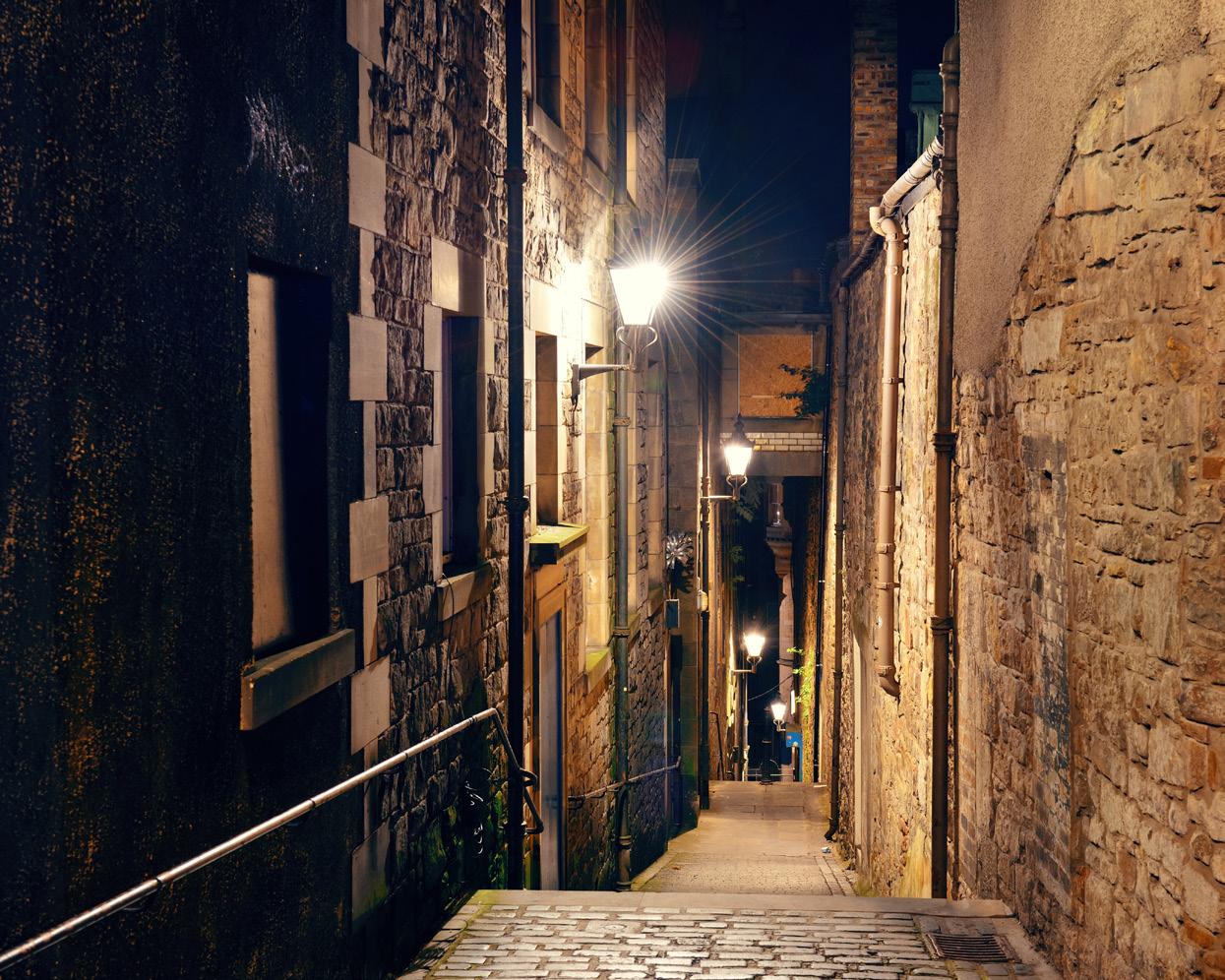
Buried beneath the city during the construction of the royal Exchange Building in the 18th century, sits the unnerving site of many urban legends. Taking its name from a past resident, the once bustling passageways lined with houses and businesses today lie desolate and eerie, buried underneath the vibrant city above.
It’s no surprise then that there have been multiple supernatural sightings since its reopening to the public in 2003, including that of Mary King herself and multiple victims of the infamous 1645 plague. Perhaps its most famous resident is the ghost of Abandoned Annie, the spirit of a child who succumbed to the plague; Annie has been spotted wandering the Close looking for comfort, prompting many visitors to leave toys and dolls for her.
“Today, people rub the nose of the faithful terrier as it’s thought to bring good luck.”
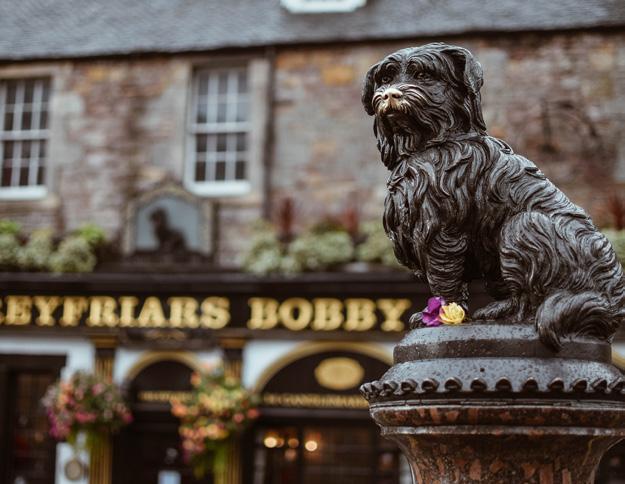
Amongst the ghosts and criminals there are also some more lighthearted tales to be told. One of the most charming is the story of Greyfriars Bobby, a Skye Terrier who frequented Greyfriars Kirkyard in the 19th century, guarding his owner’s grave for over 14 years. His story captured the hearts of the nation, and a commemorative statue was erected nearby in his honour. Today, people rub the nose of the faithful terrier as it’s thought to bring good luck. Over time, this tradition has worn away the paint coating, leaving a gold-nosed, but just as endearing, statue.
A look at the stories of Edinburgh wouldn’t be complete without a mention of the magical world of Harry Potter. Author J.K.rowling lives in the city and wrote much of the initial books in its cafes. It isn’t hard to see the city’s influence on her creation.
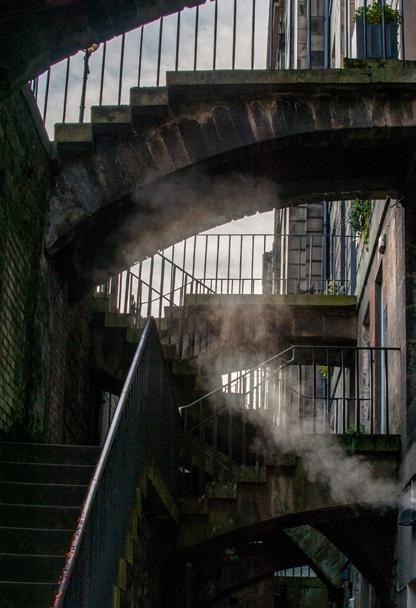
Walk down Victoria Street, a winding road adorned with colourful restaurants and shops, to find the inspiration for diagon Alley. The intricacies and grandeur of multiple Edinburgh institutes, like the Castle and George Heriot’s School, complete with their towers and turrets, are also believed to have inspired the imposing style of Hogwarts.
rowling was even said to have wandered Greyfriars Kirkyard to find inspiration for her character’s names, and it’s here you’ll find Potter, McGonagall, and Tom riddle laid to rest.
Whether you’re after an encounter with an unsettled ghost or instead want a more family-friendly spooky experience, get in touch with our Europe team today to start planning.
→ murray@jacadatravel.com

Wandering through traditional Greek villages in an attempt to understand the omnipresence of the evil eye or ‘mati’, short for ‘matiasma’.
Greece is chock full of superstitions and fateful traditions. In addition to gods and demons, there is often the belief that negative energy may also be passed from one person to another, in the form of a malicious stare. The mysterious curse of the evil eye is millenia old. dating back to early Mesopotamian civilizations, it predates ancient roman and Greek times. To this day, it intertwines with numerous cultures around the world and has evolved into a widespread folk concept. And as with all stories that stretch back to antiquity, it can be hard to separate truth from myth.
It is believed that mati, the evil eye, is caused by a spiteful glare with negative intentions, such as jealousy, envy or malice. It is also understood that anyone can give a bad eye quite unintentionally, and sometimes simply by complimenting another person. The instant impact resulting in bad luck, loss or in many cases injury and disease. Symptoms of being ‘matiasmenos’ or afflicted by the evil eye, include (but are not limited to) inexplicable dizziness, nausea, headaches, extreme fatigue, stress and unreasonable negativity in work or personal life..
Because the power of the evil eye has often been said to be involuntary, avoiding the curse has been a lifelong game. Interestingly, the superstition gives us a possible insight into why the people of Greece have developed a mock-spitting gesture when praising another. “Ptou sou na min se matiaso” as said by the Greeks, usually after paying you a compliment. roughly, this translates into “I’ll spit on you so I don’t put the evil eye on you.”
In both Turkey and Greece, it is common that an eye amulet is used to deflect the evil eye. More than just a souvenir from a Greek vacation, the evil eye is an ancient symbol of protection, stemming from a folk belief with a long history in tradition. It is believed that the powerful protective talisman will ward off the curse and keep you away from bad luck. designed in the shape of an eye, the apotropaic charms are traditionally in shades of blue, or green. Some say it is because people with light coloured eyes are more likely to bestow the curse.

Because it is thought that women and young children are especially vulnerable to the evil eye attack, it is also very common for mothers to put an evil eye pin on their baby’s crib with the hope of redirecting negative energy away from their child’s life.
Come New Year’s, it’s not unusual for Greeks to gift each other an evil eye item or gouri. These lucky charms are usually hung in front of someone’s house door. Other techniques include hanging braids of garlic, which are believed to protect against spirits and demons. As you might expect, it isn’t uncommon for the more suspicious to carry a garlic clove in their pocket.

Measures taken to ward off the evil eye vary from culture to culture. Xematiasma is the healing ritual practised in Greece. According to tradition, the ceremony can only be effective if the person conducting it is of the opposite gender. It is also preferably performed by someone close to the affected person, in most cases, the grandmother or yiayia
In Greece alone, there are several ways to perform xematiasma, it's a ritual that’s widely accepted and practised in public. Following the vaskania (the Xematiasma prayers), the ‘healer’ drops some holy oil in the cup of water and observes it. The prayers (often barely audible) and the crossing are performed three times, followed by another drop of oil in the water. Each time the oil is dropped into the water, it is observed and assessed. If it keeps its shape and remains as a single drop, you don’t have the 'bad eye'. However, if the oil dissolves into the water, it reflects that the evil was present and has now been destroyed.
At the end of the ritual, after the victim has been asked to walk away without looking at the water and oil, and most importantly, without saying ‘thank you’, the healer might begin to yawn. This yawning is seen as proof that the evil eye was present and that the healer has now taken over the curse. A particularly malicious evil eye will result in strong and lengthy yawning from the healer.
Curious to know more? delve into the vast history and culture of ancient Greece on a walking tour of traditional Cretan villages → hanna@jacadatravel.com
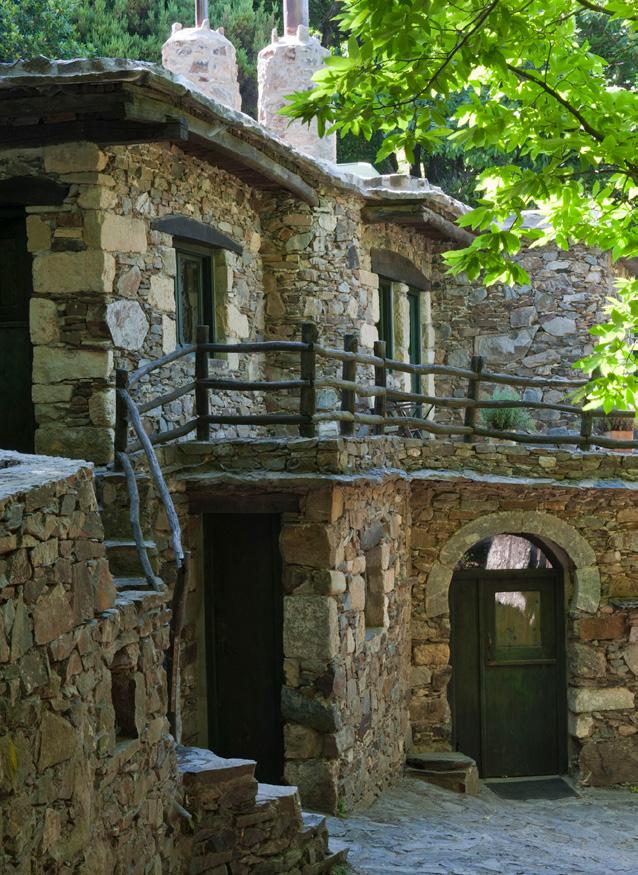
Exploring the traditional trades and tenacious characters of Quito’s Old Town.
Words: Jessie Brechin
Photography: Alicia Warner
Founded in the 16th century on the ruins of an Incan city, Quito is known for having the best-preserved old town in Latin America. In 1978 it was named, along with Krakow, as the world’s first UNESCO heritage site.
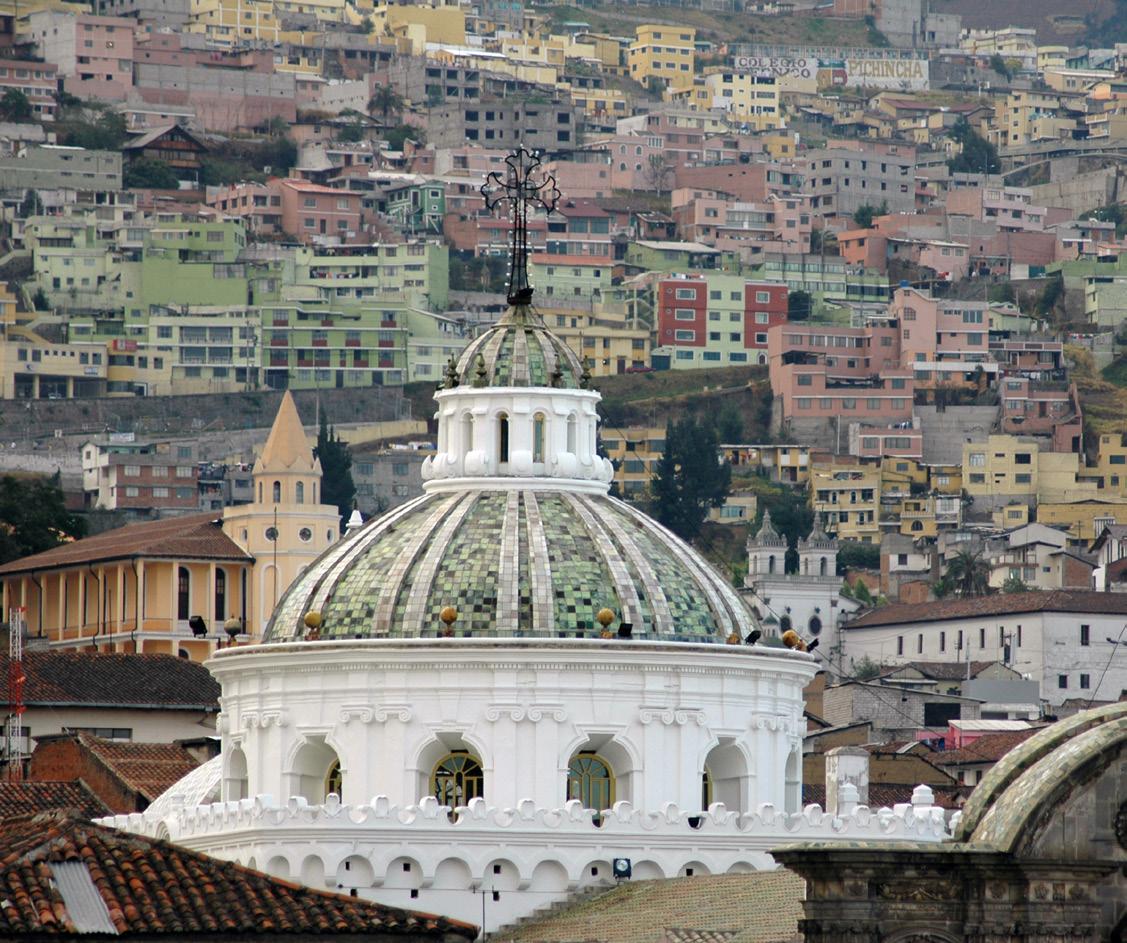
Situated in a dramatic valley, the classic steep streets, open squares and opulent churches showcase its Spanish heritage.
In recent years, however, the Old Town has struggled to keep up with the changing pace of life in the capital. Many buildings have fallen into disrepair and there are few original residents remaining, making business tough for the local traders and shopkeepers.
Organisations like Caminos San Roque are fighting hard to maintain the culture of the area. On a recent trip to Ecuador, we met some of the tradespeople who bring such a unique character to the city and keep its traditions alive.
Discover Quito → jen@jacadatravel.comTop right. Patricia has been selling ‘aguas medicinales’ (traditional drinks considered to have medicinal properties) in the area since she was a girl. She is the fourth generation of her family to do so.
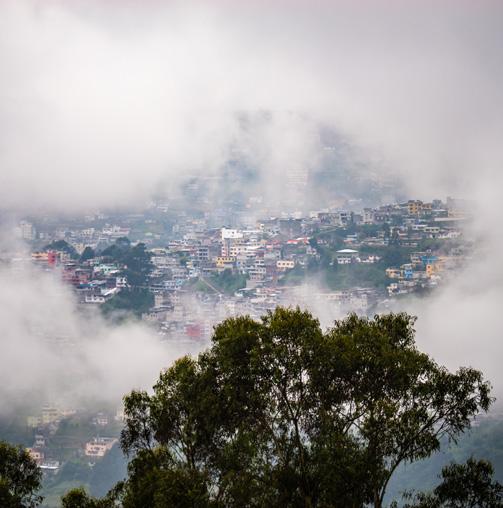
She loves selling her drinks on the street and in the market, and leading tours of the area because it gives her the chance to meet people that she wouldn’t otherwise. Patricia’s most popular drink is horchata,made from a combination of 28 different plants.

Bottom left. Hats are big business in Ecuador - the misnamed Panama hat was originally from here. At this traditional millinery shop can see how the hats are made and learn about the types favoured by different indigenous groups.

Bottom right. The placement of a peacock feather on this ladies’ hat is about more than just style. depending on how high the feather is, those in the know can tell whether a woman is single, engaged or married.

Top left. José runs his family’s business repairing religious artwork and figures. His small shop is full of figurines and altars brought by people from the area and beyond.
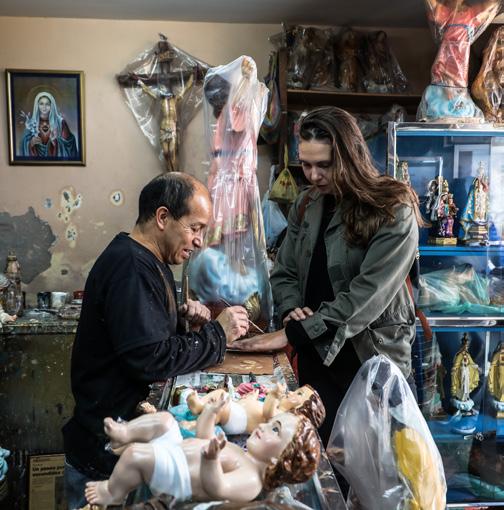
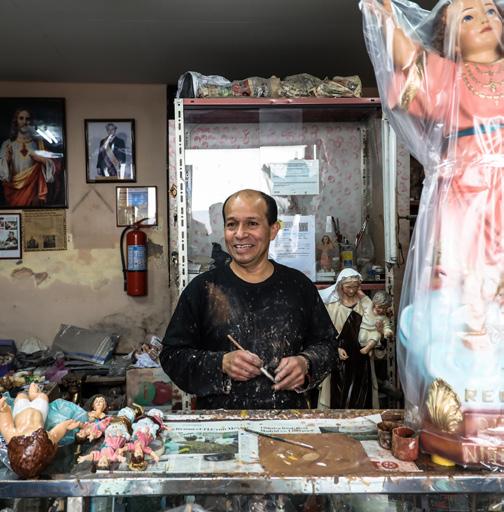
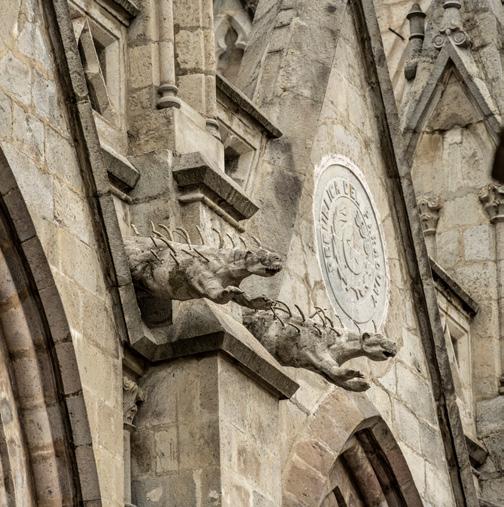
Top right. The other reason that José’s shop is popular is because of the curative properties of the paint compound that he uses. People come with small wounds and scars to have them painted and, just a few days later, see them fade away.
Above. rosa has one of the posts in the market where people go for traditional medicine. As the fifth generation, she has been practising since she was a girl, and performed her first ‘limpias’ when she was 10 years old.
Her shop is piled high with herbs and plants, as well as other remedies such as ‘dragons’ blood’ and seeds.
Right. Clients are attended to either at home or right in the shop. rosa carefully selects her remedies before sweeping them over the body to rid the patient of their malady.
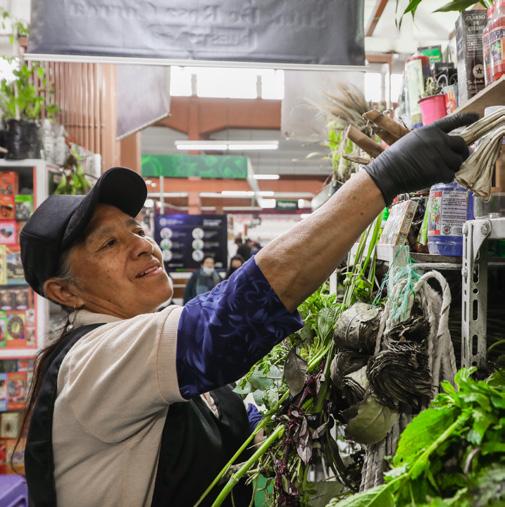
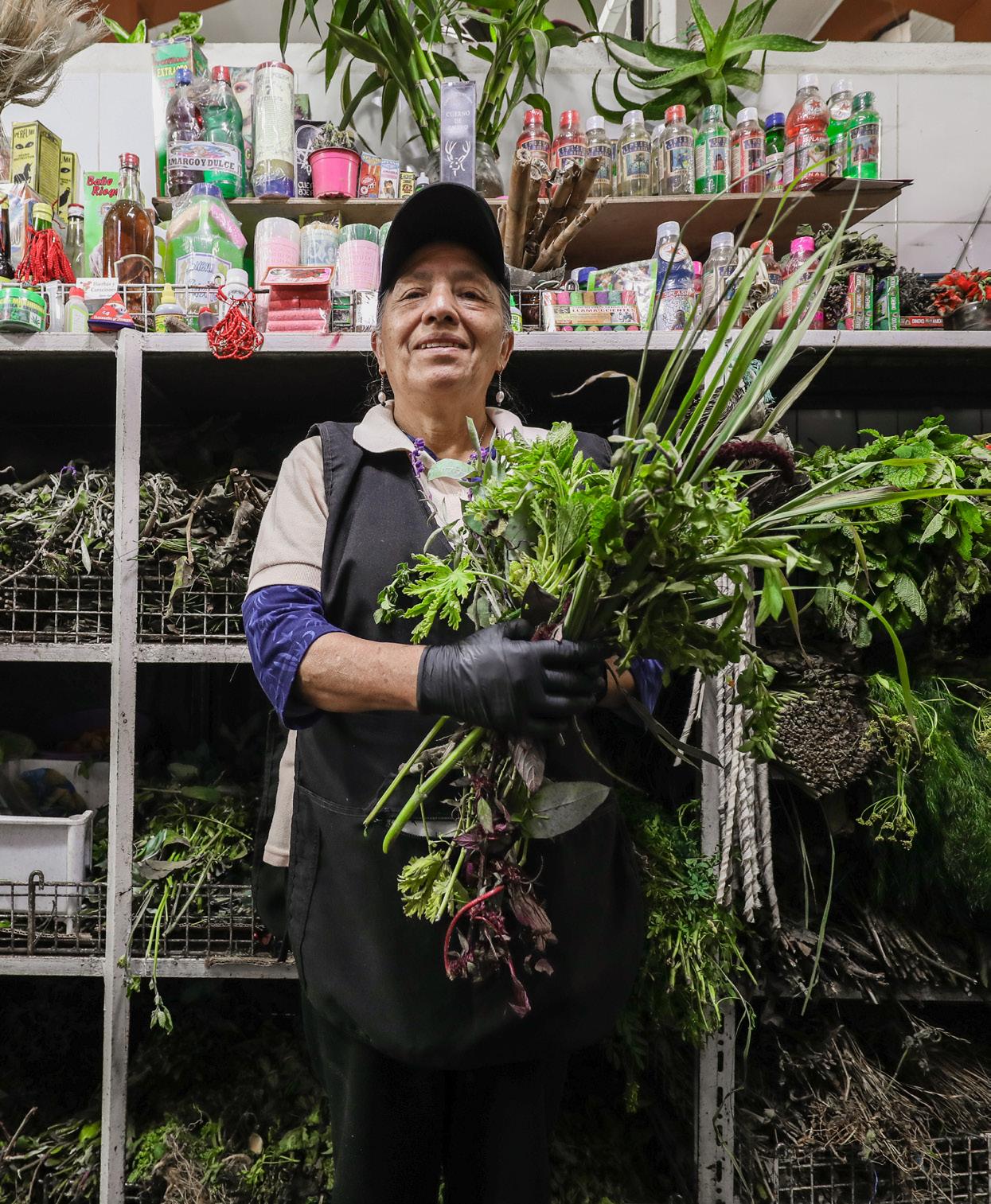
Spanish culture has been woven into the intricate strands of Moroccan heritage for generations. With parts of the north held by Spain as early as the 1500’s, it’s no surprise Spanish influences in Morocco are palpable.

In Moroccan kitchens and food markets, heady flavours, smells and joyous tastings tell the tale of the little Spanish pastilla that became a mainstay on the local menu.
Pastilla is the Spanish word for ‘small pastry’ or ‘pie’. The exact story of the chicken and almond pastilla’s genesis in Morocco is curious. Some believe the spice combinations came with the Moors and Sephardi Jews in the 1500’s, whilst others speculate much later, during the Spanish protectorate of 1912. Either way, there’s no denying the Moroccan favourite is of Spanish descent.
This elaborate pastilla is made with werga dough (a cousin of filo pastry) and then stuffed with tender meat. The meat is slow-cooked with a concoction of spices including saffron, to form the succulent filling. Once assembled, a crunchy layer of toasted and ground almonds, cinnamon and sugar are smothered over the pastry, forming a crisp, tasty shell. different parts of the country tell their own tale with the pastilla using
alternative fillings; lamb or pigeon in the north and seafood on the coast - it’s an adaptable dish.
Sourcing the ingredients, particularly the meat and spices, involves a visit to an energetic local market or a quaint, colourful souk. Spices are tremendously important in Moroccan cooking, with as many as ten spices used in everyday dishes. Hundreds of market stalls precariously balance sacks, baskets or metal containers, filled with bright reds, yellows and earthy browns. The spices are shaped to form tall cones, peeking out from behind one another, creating a mini desert of spiced dunes.
Aside from this tasty pie, on adventures across the country, it’s impossible not to notice Spanish influences elsewhere. Tangier’s wide boulevards were built to accommodate the ‘paseo’, the Spanish habit of strolling in the evenings. In the north, some locals speak Spanish and listen to Arab-Andalusian music, known as ‘al moussiqa al andaloussia’. Even as far south as Marrakesh you’ll find the spanish sandwich, bocadillos, on cafe’s menus.
Left. Vibrant spices are a staple in Moroccan cuisine and decorate the colourful souks.Whether going behind the scenes of an exceptional restaurant or learning from a local’s home, there’s no shortage of ways to get an immersive culinary experience in Morocco.

A Moroccan cooking class at La Maison Arabe
Inside a beautiful Moroccan riad, led by a dada (traditional Moroccan cook), get to learn all the best-kept secrets of Moroccan cuisine. After your lesson, settle down and enjoy the sumptuous meal you’ve prepared.
A city tour of Marrakech and Fes
Guided city tours in Marrakesh and Fes are also a fantastic way to immerse yourself in Morocco’s culinary culture. Accompanied by a local guide, you will be led through mazes of streets and alleyways on the search for the city residents' favourite spice markets - a uniquely rewarding experience.
A culinary tour of Jemaa el-Fnaa
Tasting local dishes, as a local, is an experience not to be missed in Morocco. A street food tour in Marakesh’s Jemaa el-Fnaa will awaken all your senses as you stop at the most tempting food stalls. Snake charmers and acrobats add to the festivities in one of the world's most emblematic night markets.
Explore our scrumptious gourmet tours → jacadatravel.com
/food-and-wine
The Mãori share a unique relationship with their stunning homeland.

New Zealand is the type of destination to take the breath away from even the most seasoned traveller. Whether it’s your first or tenth visit, there’s no getting over its natural beauty, from the vast snow-capped mountains to the white sandy beaches and lush greenery that decorates it.
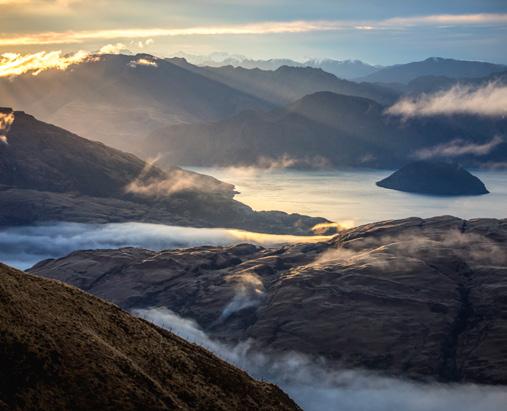
The Mãori have called New Zealand, or Aotearoa, their home since the early 14th century, after travelling over from East Polynesia. In these early days they were relatively isolated, and as a result created a strong culture, with a distinctive language, belief system and way of life centred around nature.
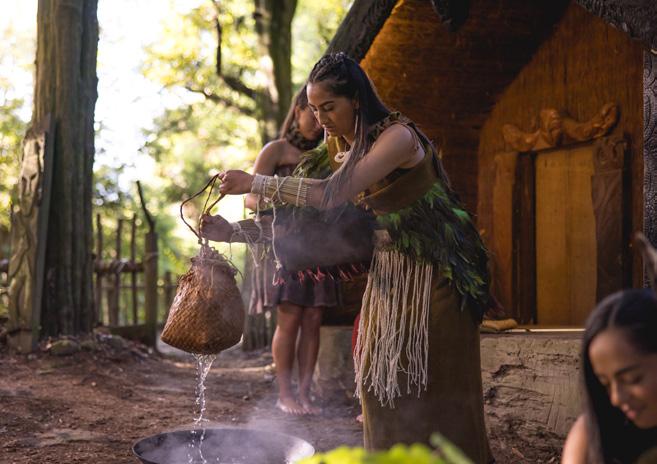
They formed a world-view, termed te ai Mãori, which focused on human relationships with the world around us. Believing that all people, plants and animals descended from the sky father and earth mother, the Mãori identified a deep, profound relationship between humans and nature. This belief extended to an understanding that, like us, plants and animals have a soul and must be protected and respected.
There’s an important and somewhat illustrious group of people known as the Tangata Whenua in Mãori culture. This group are said to have descended directly from the land that they live on, and as such they have a great authority over that land. This term also describes the Mãori as a whole, as they’re similarly understood to have originated from the land.
According to the Mãori, great responsibility is said to lie with humans who are considered guardians with an obligation to care for and preserve the land they inhabit, a concept known as kaitiakitanga. There’s no question that this idea of care and safekeeping is crucial today, with global warming threatening our vital resources. We have an extraordinary chance to make changes that may preserve our world for future generations; we’re all trying to drive less or recycle more, and it’s these small steps which are a lifeline in our fight to conserve and protect the planet.
remarkably, the Mãori are commandeering vital changes in New Zealand to conserve the land, like introducing policies that have given whole natural areas legal rights and protection. The Te Urewera Act 2014 and Te Awa Tupua 2017 gave their namesake rainforest and river the same rights as a human in a court of law.
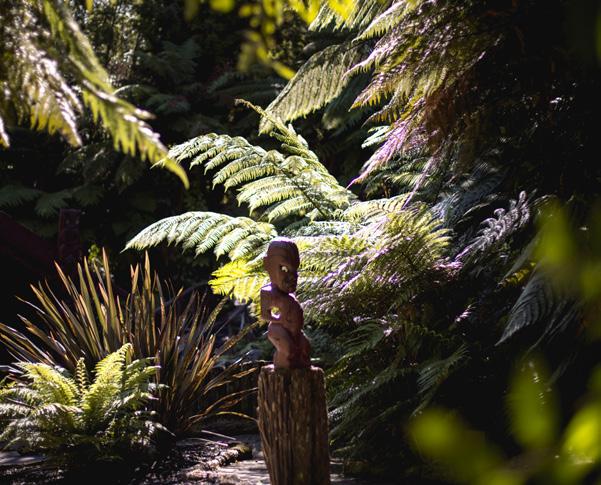
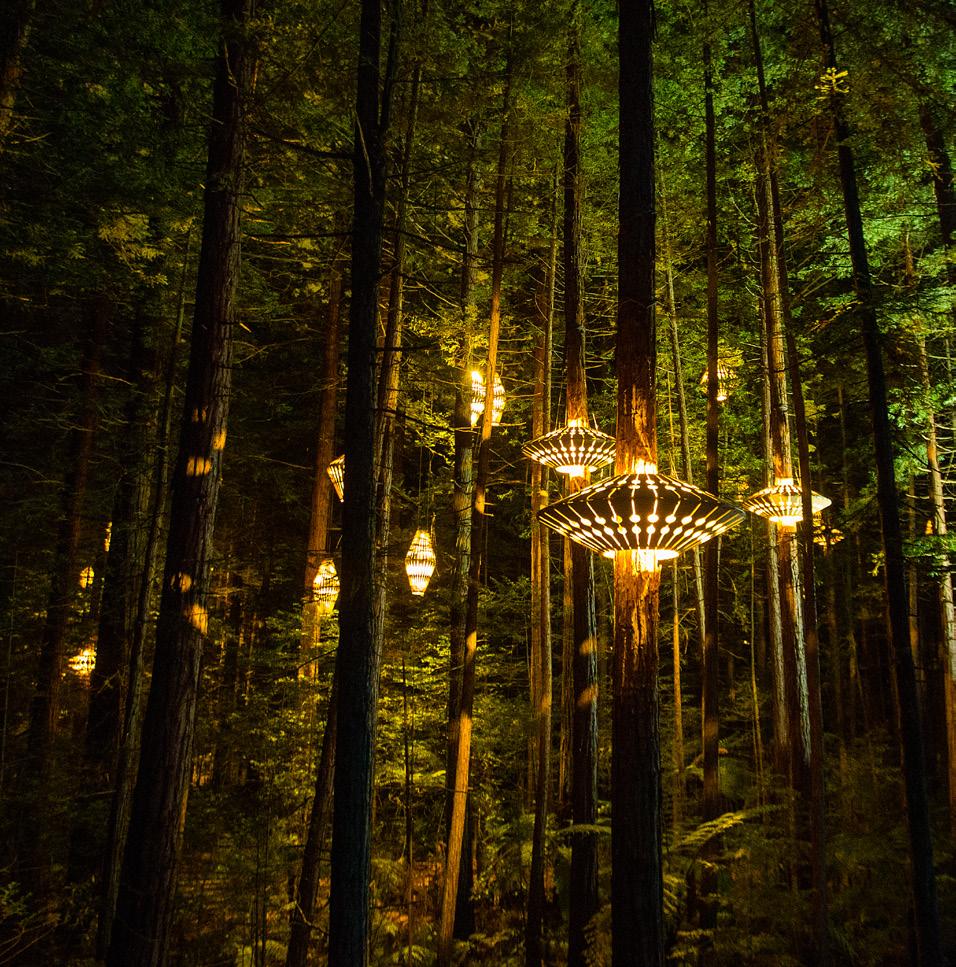
These changes didn’t happen overnight, and it’s a consistent and steadfast commitment to protecting the land that’s influenced a real change. Mãori often place strict restrictions on areas to stop people from harvesting certain resources, a practice known as rãhui. Fishing has been banned in certain rivers while fish numbers replenish, and sections of forests are off-limits to give trees time to grow back.
Experience New Zealand
despite being small, New Zealand is a country that will totally captivate you; with beautiful scenery and such an endearing culture, it’s easy to see how it’s a bucket list destination for so many.

A huge reason that many return time and time again are the people, who welcome visitors with open arms. Enjoy a private dinner in a Mãori home, learning more about the people and their culture whilst tasting some of their best-loved dishes.
don’t expect the adventure to stop come nightfall, as you can explore rotorua’s forest of lights under the shroud of darkness. This magical walk takes you along a suspension bridge, beautifully strung up between 22 Californian redwoods, each adorned with hanging lanterns. designed by famous artist david Trubridge, it’s a truly mesmerising way to explore nature.
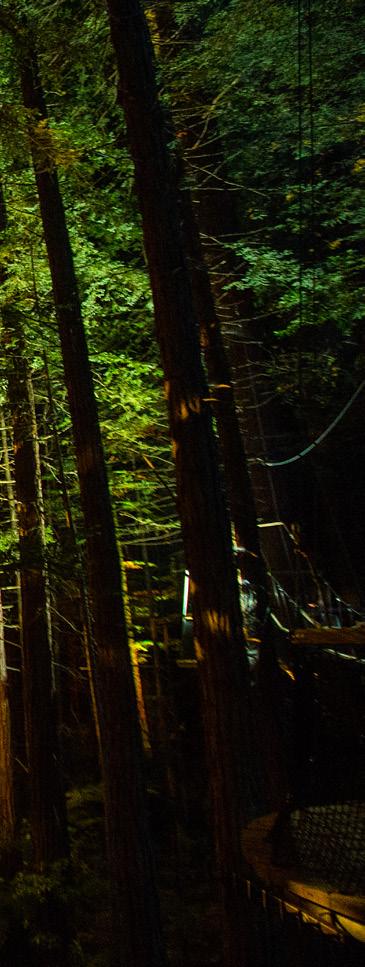
New Zealand is a playground for those who enjoy the outdoors, and with such a stunning diverse landscape it’s unsurprising that it’s home to some of the world’s best hikes. The r otorua area is particularly sought out by hikers who explore the lush forests of Tikitapu or the spectacular Okere Falls. Any hike you embark on will guarantee unparalleled natural beauty, wildlife and a deeper understanding of the culture. Venture to the summit of Te Mata Peak for a stunning view of Hawke’s Bay and the Heretaunga Plains, and learn all about the local legend of a giant who once roamed the land. Experience a display of true hospitality when you visit a marae and receive a powhiri, an epic welcoming ceremony by the Mãori involving their signature singing and plenty of food. Or, broaden your understanding of the individuality of the many different tribes by visiting Nga Pou o Heretaunga. It’s a brilliant collection of 18 impressive two-metre-tall carvings, each with intricate details and vibrant colours representing the subtribes of the area.
ready to escape to the other side of the world? Let us plan your perfect trip.
→ ellie@jacadatravel.com
"Explore Rotorua’s forest of lights under the shroud of darkness."
Celebrating 40 years as a leader in conservation and hospitality, our parent company Wilderness has embarked on a new journey. It’s an exciting story that we’re proud to be part of…

It all began in 1983, when two passionate guides set off on a daring adventure to the ‘Mother Continent’, Africa. What started out as a wander through the untouched wilds of Botswana turned into a fiery love story - one of a lifelong fascination with Africa.
And it’s easy to see why. As the world’s oldest inhabited continent, Africa is justifiably famous for its wildernesses, wildlife and people. It’s home to everything from the smallest form of life, to the most majestic and powerful.
As landscapes go, there aren't many other places on Earth that offer so much variety. You can find anything; from flaming sand dunes, lush mountains, rolling grasslands and winding deltas.
Charmed by all this beauty, these two dedicated safari guides set out to inspire more people to explore and fall in love with Africa.
In 1985, Wilderness Safaris built its first camps and by 1995 they were ready to expand into a new country: Zimbabwe. Fast forward to today and Wilderness is a leader in conservation, community uplift-


ment and low-impact luxury travel in over 60 destinations, across 8 African countries. In 2020, the Jacada brand joined the Wilderness family, and together we continue to create bespoke travel experiences around the world.
Next year, Wilderness will be celebrating four decades in the hospitality business. To mark this special occasion, they’ve planned a bit more than just a party. They have announced a great rebrand; with a whole new look, fit for the future.
They are also working to increase the world’s wilderness with the ambitious goal of doubling the 2.3 million hectares of land they help protect by 2030. This objective only adds to their long list of success stories. In 2022, Wilderness Bisate’s reforestation Programme in rwanda has recorded a milestone of 70,000 trees planted, and there’s more to come…
Here’s to an exciting Wilderness chapter as they bring guests on more expeditions to explore Earth’s ultimate untamed places.
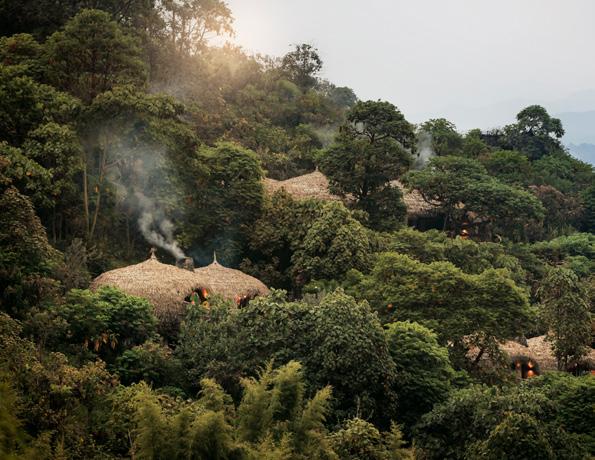
Long-time Jacada client and keen photographer Jacqueline chatted to us about her and her husband Bob’s favourite kinds of trips, how their style of travelling has changed now that they have a toddler, and how photography and travel are inextricably linked for them.

What are your priorities when you’re planning travel? In the very beginning my first priority was more around the comfort of the lodges - if there was a hairdryer, that was a plus! But then, over time it started to become more about being in remote areas, and seeing something more unique, even if that meant less animal density. So, it was okay to drive for a long time without seeing an animal. And I discovered that is something that I really like, being disconnected from the world for a bit. It gives you a more raw experience.
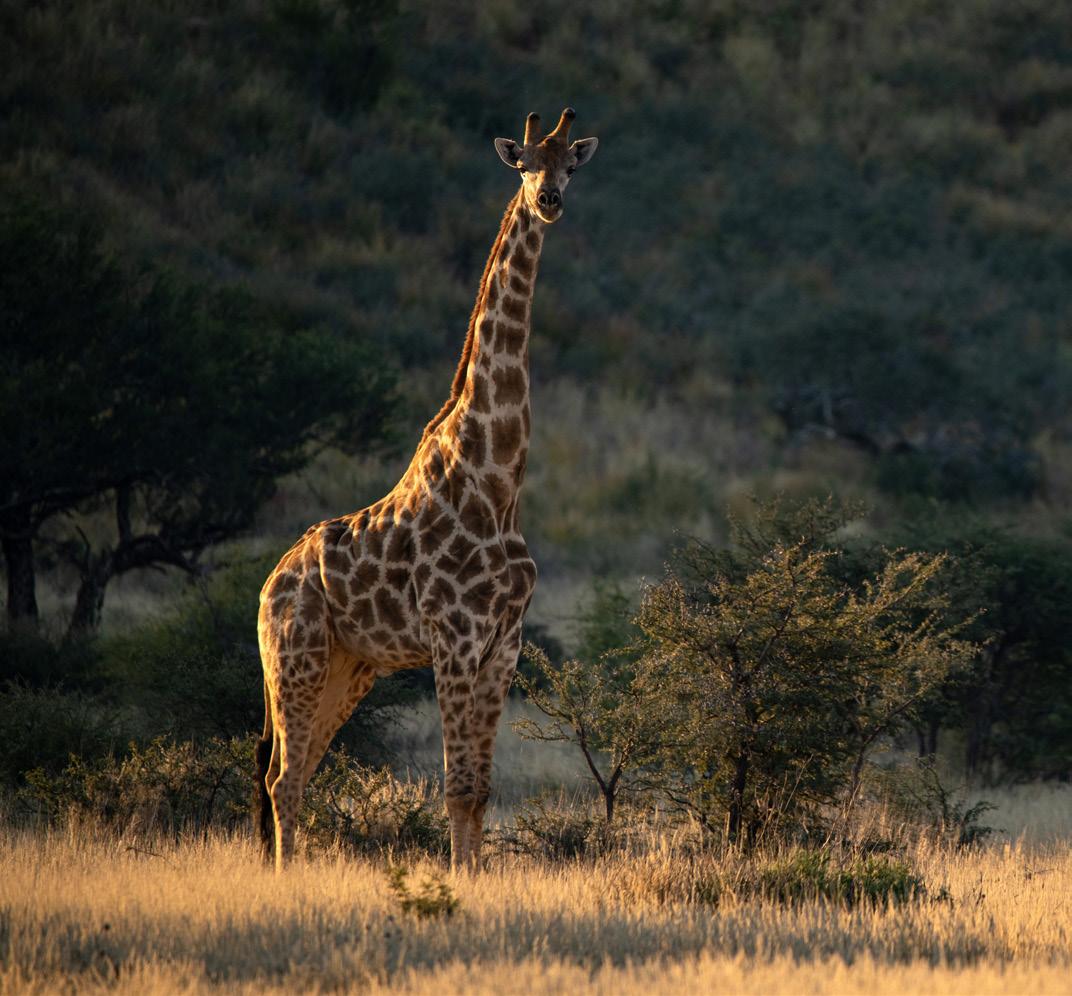
Photography has also always been important to us, so being in the right place at the right time was a huge priority. Jacada has always helped us get really good guides, making sure that we had someone great to take us on our journeys.
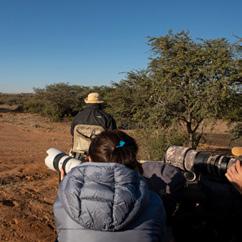
Has this changed now that there are three of you?

And then the little one came along! We made the mistake of maybe accommodating him a bit too much in the beginning. On our first trip with him to South Africa we chose a lodge that was really nice and comfortable, but we really missed the remoteness. driving along the fence line wasn’t as wild of an experience as we would have liked. Going forward we’ll choose destinations that fit us, and come at it from that angle.
What inspires you to travel and where do you get your ideas?
Often we just want to go somewhere that’s really quiet, because back in the city - I’ve lived in Hong Kong and Singapore - it’s really very busy. The pace of life is quick, there’s stress, and there’s your phone that’s constantly buzzing. You kind of just want to go to places that just ground you, and remind you how amazing the world is. The scenery, the natural phenomena, it all reminds you that life is much much bigger than just you.
We hear you’re working your way through a very specific travel list. Tell us about that.
It’s kind of our version of a bucket list. My husband and I find we both really like wildlife photography, so it is a special bucket list of what we want to see and what we want to photograph. Hopefully we’ll make it to all the places!

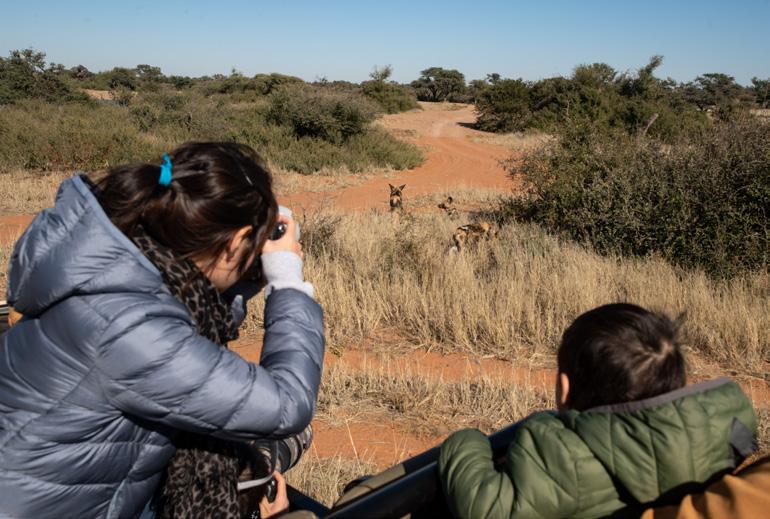
The first thing we put on the list was probably somewhere in Africa. It is one of my favourite places. I’m really interested in the Polar areas and South America too.
Any favourite places you’ve been or experiences you’ve had and why?
There’s too many. Each one is special in its own way. What stands out for me though, even after all this time, is enjoying sundowners in Tanzania. We’re not really sundowner people anymore because we’re always chasing the golden light with photography, but what really sticks in my memory was when we were at Chem Chem near Lake Burunge and they had set up this area for us to have a sundowner with some snacks and the sun was setting. There were all sorts of fantastic colours and in that moment we just felt so still. really peaceful.
And then another favourite was Namibia and the stars. I could almost see the Milky Way with my naked eye. It was amazing, your heart just stops for a moment looking up because it’s like “Is this real?”
Are there any destinations you’d go back to, and any you’re still looking forward to?
I’d want to go back to all of them. One thing I wish we did before we had Zac was gorilla or chimp trekking. That is very difficult for us now, unless we leave him with the lodge babysitter or nanny service. So, I wish we’d ticked that off the bucket list first, because it might be another 10 or 15 years before we get to see it with him.
One thing I’ve found really interesting is that every time we take a trip with him he seems to have a mental or physical leap. So like, before we went to South Africa he was counting verbally, but I don’t think he understood the exact link between numbers and quantity. But within a week of the trip he suddenly understood that link and the full alphabet. Then we took a short weekend getaway and when we came back he knew how to scooter by himself. Independently. Obviously I’ll have to see after a few more trips if this is really a pattern. If it is, it’s quite amazing because it means travel is beneficial to their little minds.
Is there anything that you think ties together the places you’ve loved?
What I love the most is when there’s really great scenery, so the plains just don’t end. Like the Serengeti, or Namibia’s Skeleton Coast - it just keeps going and going.
And you really feel like you’re out in the wild. And then of course having a really great lodge kind of seals the deal for me, because there’s good service, good food. So you don’t feel like you’re cramping yourself. You’re well fed, you’re well hydrated, and you still get to experience that wildness.
Tell us about how travel and photography come together for you
Sometimes game drives are really long but photography is something that gives us a job, almost like a goal that we want to achieve. “Okay, at the end of this we’re hoping we can tick these items off our bucket list for photographs.”

The second thing is that I keep a photo book after each trip. Of where we’ve gone, what we ate, where we stayed, what we saw, stuff like that. It’s always good for memories to have some photos.
And sometimes it really is just about luck. For example when we were in Namibia we saw the desert leopard. Having a photograph brings us right back to that memory. These days I don’t really remember what I saw or what I ate, or what the feeling was. But when I look at my photo book I get transported back to that moment, and relive it. And that’s pretty amazing.
Where to next?
We’re still deciding, but possibly Sri Lanka. We’re thinking of maybe taking the opportunity to visit somewhere with fewer tourists while we can.
How will you travel with Jacada?
Start your adventure. → enquiries@jacadatravel.com
relive it.
that’s pretty amazing."
"When I look at my photo book I get transported back to that moment, and
And

A scenic helicopter ride above the Great Barrier Reef? It’s on us.

Personal recommendations mean a lot to us. When you introduce a friend or family member to us we’ll always take great care of them. We’ll even sprinkle a little something extra on their trip to welcome them to Jacada.
And as a thank you for spreading the joy, we’ll do the same for you when you next travel.
Who will you share the magic with?
Email referrals@jacadatravel.com or get in touch with the team directly.